IMC Plan and Web Discussion Report Contents
VerifiedAdded on 2022/10/18
|21
|5233
|170
AI Summary
INTEGRATED MARKETING COMMUNICATION 18 INTEGRATED MARKETING COMMUNICATION School of Business and Economics Integrated Marketing Communications Title: Final Assignment: IMC Plan and Web Discussion Report Contents Part 1 1 Introduction and Summary of Brand Audit 1 Introduction of Nokia 1 Summary of brand audit 1 Part 2 2 Identify Primary Target Audience 2 Primary target audience 2 Part 3 3 Assessment of IMC Situation 3 Internal analysis of Nokia 3 Strength 3 Weakness 3 Opportunity 3 Weakness 3 External analysis of Nokia 4 Political Perspective 4 Threat from substitution 4 Threat
Contribute Materials
Your contribution can guide someone’s learning journey. Share your
documents today.
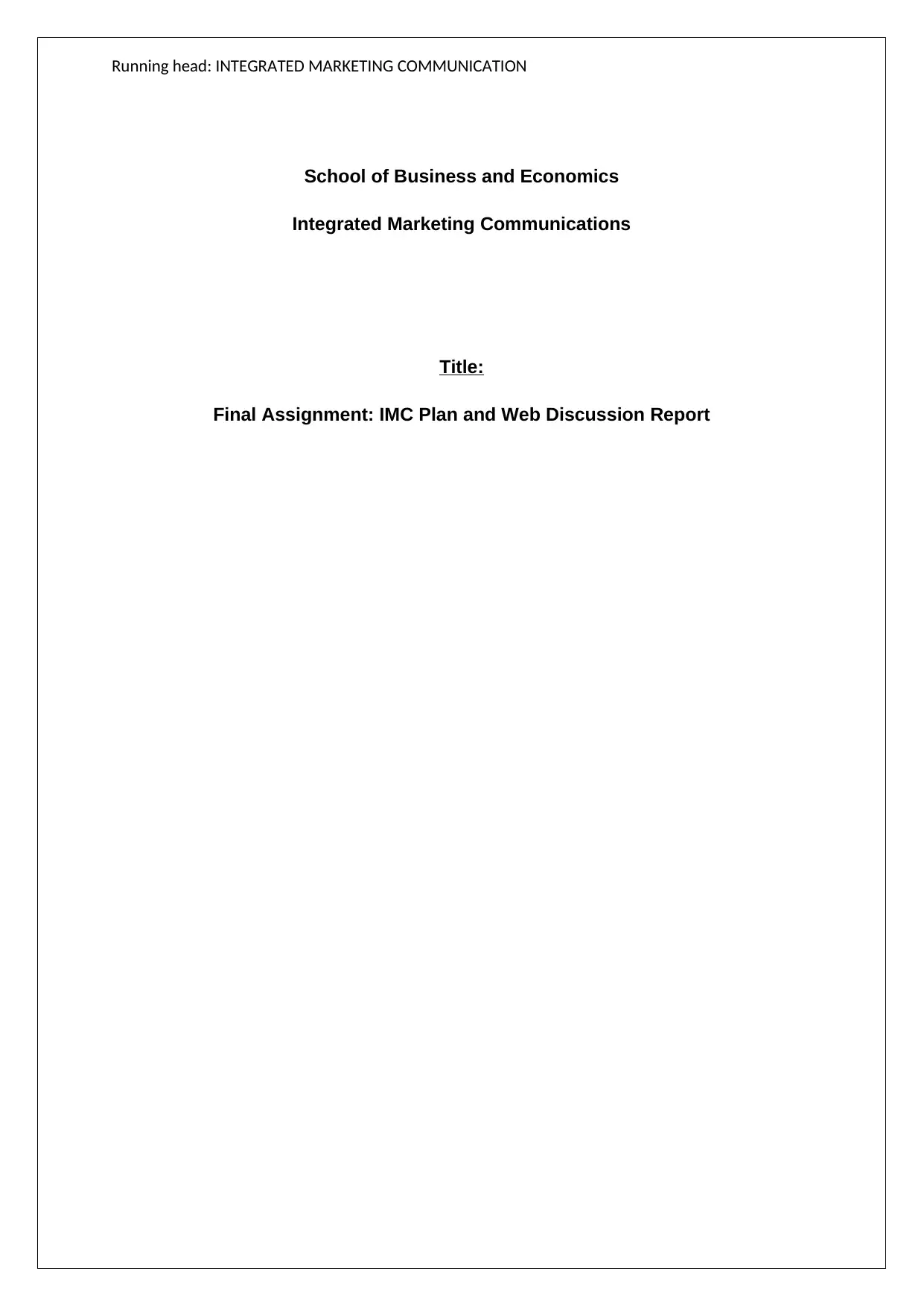
Running head: INTEGRATED MARKETING COMMUNICATION
School of Business and Economics
Integrated Marketing Communications
Title:
Final Assignment: IMC Plan and Web Discussion Report
School of Business and Economics
Integrated Marketing Communications
Title:
Final Assignment: IMC Plan and Web Discussion Report
Secure Best Marks with AI Grader
Need help grading? Try our AI Grader for instant feedback on your assignments.
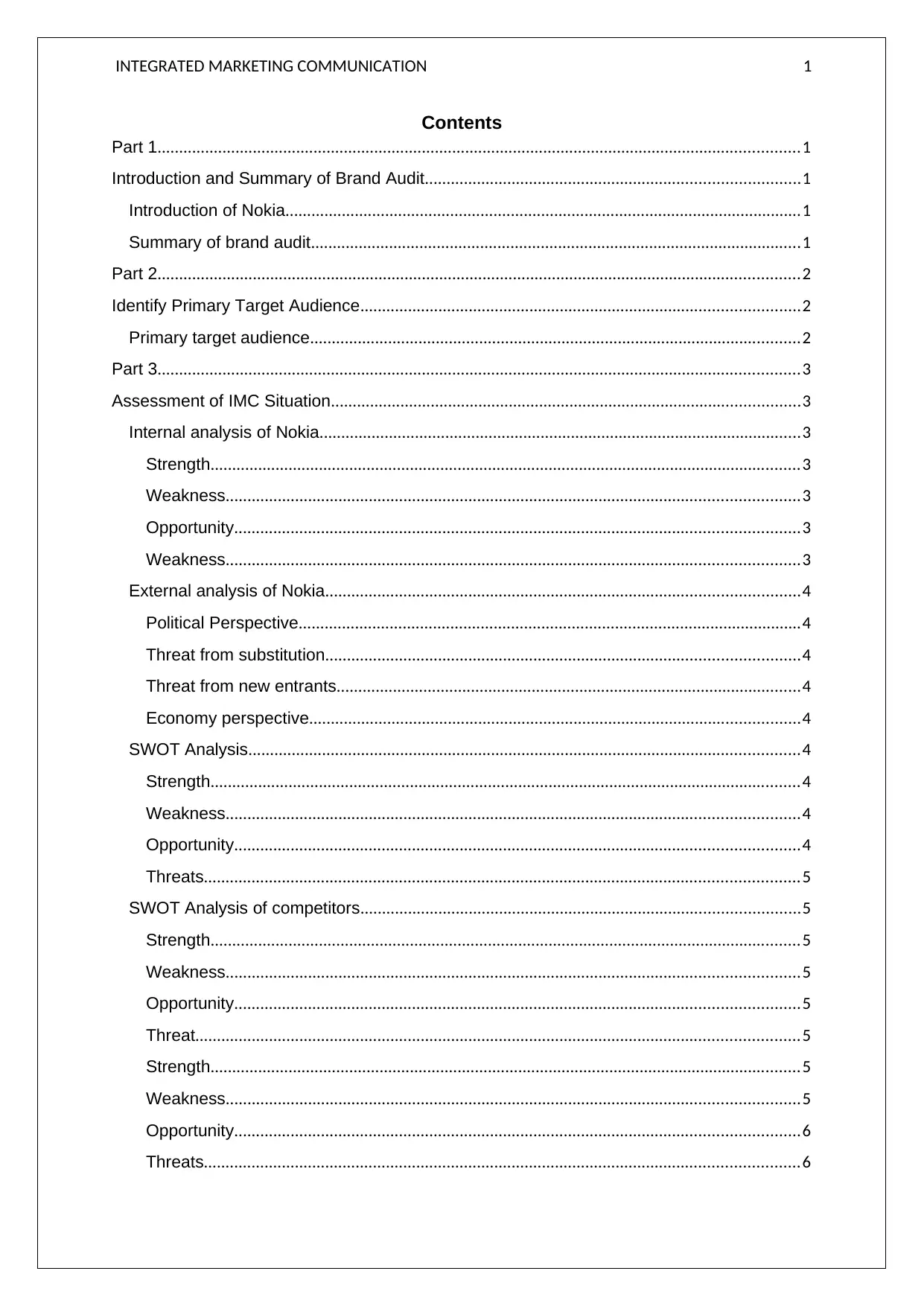
INTEGRATED MARKETING COMMUNICATION 1
Contents
Part 1....................................................................................................................................................1
Introduction and Summary of Brand Audit......................................................................................1
Introduction of Nokia.......................................................................................................................1
Summary of brand audit.................................................................................................................1
Part 2....................................................................................................................................................2
Identify Primary Target Audience.....................................................................................................2
Primary target audience.................................................................................................................2
Part 3....................................................................................................................................................3
Assessment of IMC Situation............................................................................................................3
Internal analysis of Nokia...............................................................................................................3
Strength........................................................................................................................................3
Weakness....................................................................................................................................3
Opportunity..................................................................................................................................3
Weakness....................................................................................................................................3
External analysis of Nokia.............................................................................................................4
Political Perspective....................................................................................................................4
Threat from substitution.............................................................................................................4
Threat from new entrants...........................................................................................................4
Economy perspective.................................................................................................................4
SWOT Analysis...............................................................................................................................4
Strength........................................................................................................................................4
Weakness....................................................................................................................................4
Opportunity..................................................................................................................................4
Threats.........................................................................................................................................5
SWOT Analysis of competitors.....................................................................................................5
Strength........................................................................................................................................5
Weakness....................................................................................................................................5
Opportunity..................................................................................................................................5
Threat...........................................................................................................................................5
Strength........................................................................................................................................5
Weakness....................................................................................................................................5
Opportunity..................................................................................................................................6
Threats.........................................................................................................................................6
Contents
Part 1....................................................................................................................................................1
Introduction and Summary of Brand Audit......................................................................................1
Introduction of Nokia.......................................................................................................................1
Summary of brand audit.................................................................................................................1
Part 2....................................................................................................................................................2
Identify Primary Target Audience.....................................................................................................2
Primary target audience.................................................................................................................2
Part 3....................................................................................................................................................3
Assessment of IMC Situation............................................................................................................3
Internal analysis of Nokia...............................................................................................................3
Strength........................................................................................................................................3
Weakness....................................................................................................................................3
Opportunity..................................................................................................................................3
Weakness....................................................................................................................................3
External analysis of Nokia.............................................................................................................4
Political Perspective....................................................................................................................4
Threat from substitution.............................................................................................................4
Threat from new entrants...........................................................................................................4
Economy perspective.................................................................................................................4
SWOT Analysis...............................................................................................................................4
Strength........................................................................................................................................4
Weakness....................................................................................................................................4
Opportunity..................................................................................................................................4
Threats.........................................................................................................................................5
SWOT Analysis of competitors.....................................................................................................5
Strength........................................................................................................................................5
Weakness....................................................................................................................................5
Opportunity..................................................................................................................................5
Threat...........................................................................................................................................5
Strength........................................................................................................................................5
Weakness....................................................................................................................................5
Opportunity..................................................................................................................................6
Threats.........................................................................................................................................6
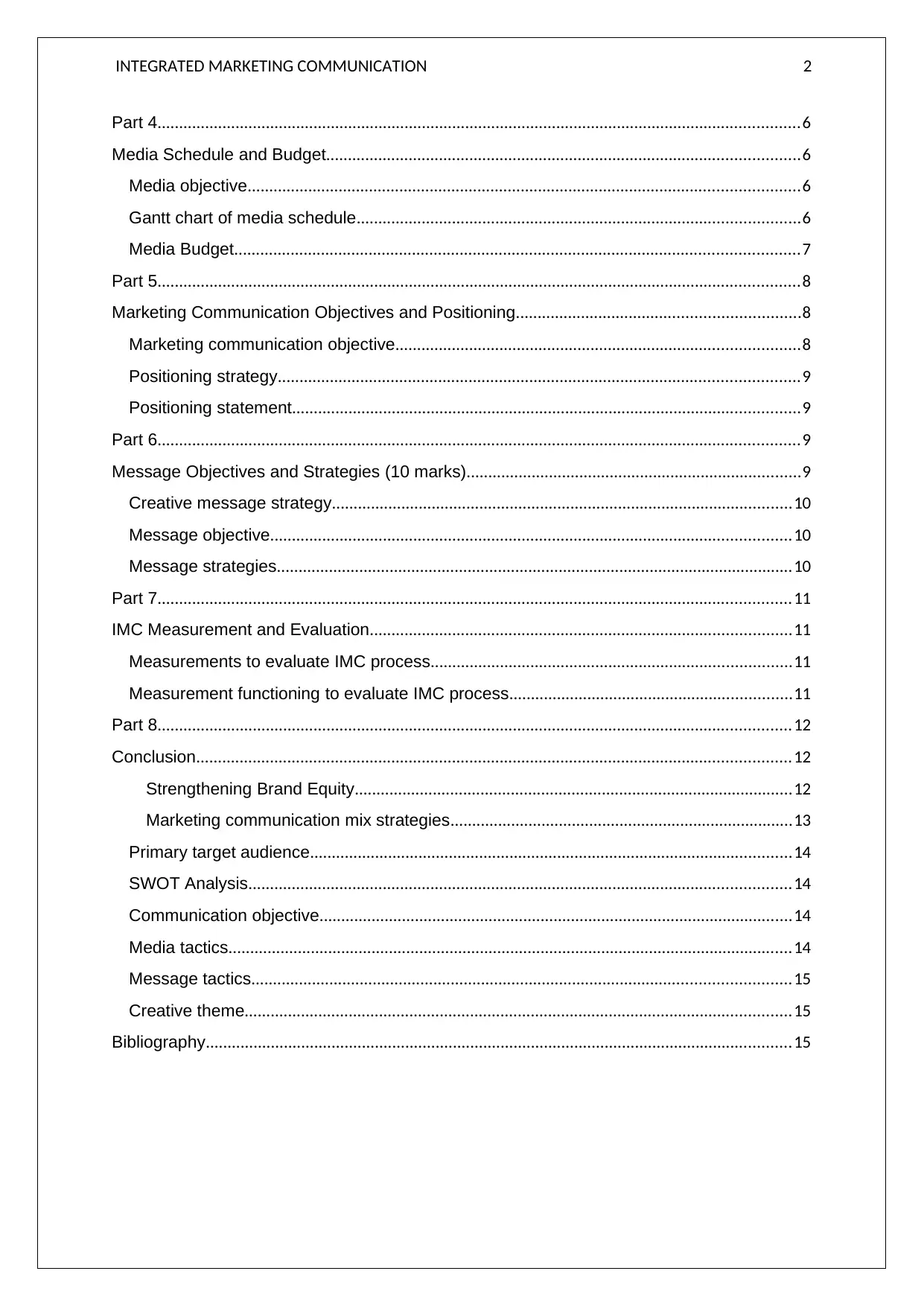
INTEGRATED MARKETING COMMUNICATION 2
Part 4....................................................................................................................................................6
Media Schedule and Budget.............................................................................................................6
Media objective...............................................................................................................................6
Gantt chart of media schedule......................................................................................................6
Media Budget..................................................................................................................................7
Part 5....................................................................................................................................................8
Marketing Communication Objectives and Positioning.................................................................8
Marketing communication objective.............................................................................................8
Positioning strategy........................................................................................................................9
Positioning statement.....................................................................................................................9
Part 6....................................................................................................................................................9
Message Objectives and Strategies (10 marks).............................................................................9
Creative message strategy..........................................................................................................10
Message objective........................................................................................................................10
Message strategies.......................................................................................................................10
Part 7..................................................................................................................................................11
IMC Measurement and Evaluation.................................................................................................11
Measurements to evaluate IMC process...................................................................................11
Measurement functioning to evaluate IMC process.................................................................11
Part 8..................................................................................................................................................12
Conclusion.........................................................................................................................................12
Strengthening Brand Equity.....................................................................................................12
Marketing communication mix strategies...............................................................................13
Primary target audience...............................................................................................................14
SWOT Analysis.............................................................................................................................14
Communication objective.............................................................................................................14
Media tactics..................................................................................................................................14
Message tactics............................................................................................................................15
Creative theme..............................................................................................................................15
Bibliography.......................................................................................................................................15
Part 4....................................................................................................................................................6
Media Schedule and Budget.............................................................................................................6
Media objective...............................................................................................................................6
Gantt chart of media schedule......................................................................................................6
Media Budget..................................................................................................................................7
Part 5....................................................................................................................................................8
Marketing Communication Objectives and Positioning.................................................................8
Marketing communication objective.............................................................................................8
Positioning strategy........................................................................................................................9
Positioning statement.....................................................................................................................9
Part 6....................................................................................................................................................9
Message Objectives and Strategies (10 marks).............................................................................9
Creative message strategy..........................................................................................................10
Message objective........................................................................................................................10
Message strategies.......................................................................................................................10
Part 7..................................................................................................................................................11
IMC Measurement and Evaluation.................................................................................................11
Measurements to evaluate IMC process...................................................................................11
Measurement functioning to evaluate IMC process.................................................................11
Part 8..................................................................................................................................................12
Conclusion.........................................................................................................................................12
Strengthening Brand Equity.....................................................................................................12
Marketing communication mix strategies...............................................................................13
Primary target audience...............................................................................................................14
SWOT Analysis.............................................................................................................................14
Communication objective.............................................................................................................14
Media tactics..................................................................................................................................14
Message tactics............................................................................................................................15
Creative theme..............................................................................................................................15
Bibliography.......................................................................................................................................15
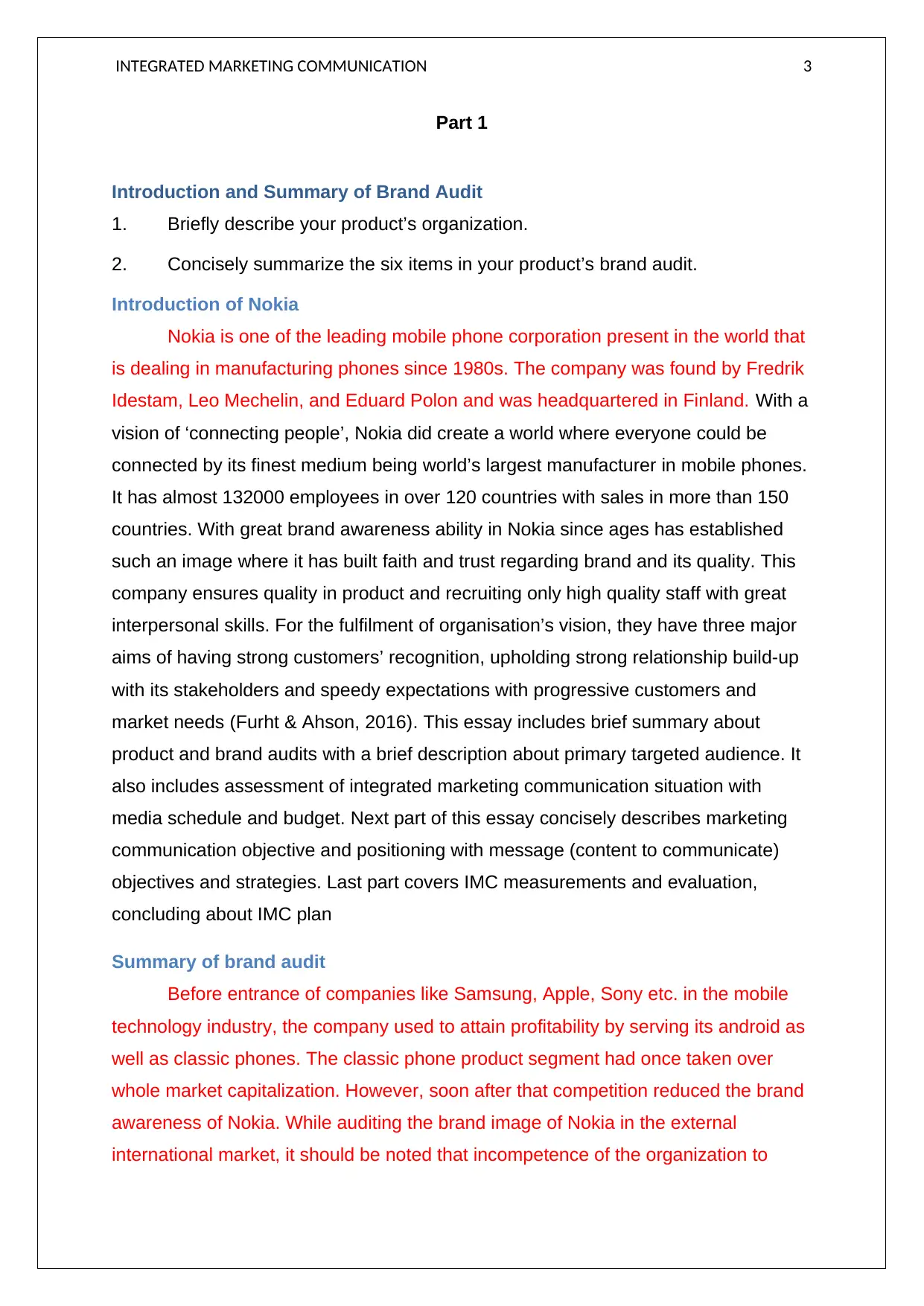
INTEGRATED MARKETING COMMUNICATION 3
Part 1
Introduction and Summary of Brand Audit
1. Briefly describe your product’s organization.
2. Concisely summarize the six items in your product’s brand audit.
Introduction of Nokia
Nokia is one of the leading mobile phone corporation present in the world that
is dealing in manufacturing phones since 1980s. The company was found by Fredrik
Idestam, Leo Mechelin, and Eduard Polon and was headquartered in Finland. With a
vision of ‘connecting people’, Nokia did create a world where everyone could be
connected by its finest medium being world’s largest manufacturer in mobile phones.
It has almost 132000 employees in over 120 countries with sales in more than 150
countries. With great brand awareness ability in Nokia since ages has established
such an image where it has built faith and trust regarding brand and its quality. This
company ensures quality in product and recruiting only high quality staff with great
interpersonal skills. For the fulfilment of organisation’s vision, they have three major
aims of having strong customers’ recognition, upholding strong relationship build-up
with its stakeholders and speedy expectations with progressive customers and
market needs (Furht & Ahson, 2016). This essay includes brief summary about
product and brand audits with a brief description about primary targeted audience. It
also includes assessment of integrated marketing communication situation with
media schedule and budget. Next part of this essay concisely describes marketing
communication objective and positioning with message (content to communicate)
objectives and strategies. Last part covers IMC measurements and evaluation,
concluding about IMC plan
Summary of brand audit
Before entrance of companies like Samsung, Apple, Sony etc. in the mobile
technology industry, the company used to attain profitability by serving its android as
well as classic phones. The classic phone product segment had once taken over
whole market capitalization. However, soon after that competition reduced the brand
awareness of Nokia. While auditing the brand image of Nokia in the external
international market, it should be noted that incompetence of the organization to
Part 1
Introduction and Summary of Brand Audit
1. Briefly describe your product’s organization.
2. Concisely summarize the six items in your product’s brand audit.
Introduction of Nokia
Nokia is one of the leading mobile phone corporation present in the world that
is dealing in manufacturing phones since 1980s. The company was found by Fredrik
Idestam, Leo Mechelin, and Eduard Polon and was headquartered in Finland. With a
vision of ‘connecting people’, Nokia did create a world where everyone could be
connected by its finest medium being world’s largest manufacturer in mobile phones.
It has almost 132000 employees in over 120 countries with sales in more than 150
countries. With great brand awareness ability in Nokia since ages has established
such an image where it has built faith and trust regarding brand and its quality. This
company ensures quality in product and recruiting only high quality staff with great
interpersonal skills. For the fulfilment of organisation’s vision, they have three major
aims of having strong customers’ recognition, upholding strong relationship build-up
with its stakeholders and speedy expectations with progressive customers and
market needs (Furht & Ahson, 2016). This essay includes brief summary about
product and brand audits with a brief description about primary targeted audience. It
also includes assessment of integrated marketing communication situation with
media schedule and budget. Next part of this essay concisely describes marketing
communication objective and positioning with message (content to communicate)
objectives and strategies. Last part covers IMC measurements and evaluation,
concluding about IMC plan
Summary of brand audit
Before entrance of companies like Samsung, Apple, Sony etc. in the mobile
technology industry, the company used to attain profitability by serving its android as
well as classic phones. The classic phone product segment had once taken over
whole market capitalization. However, soon after that competition reduced the brand
awareness of Nokia. While auditing the brand image of Nokia in the external
international market, it should be noted that incompetence of the organization to
Secure Best Marks with AI Grader
Need help grading? Try our AI Grader for instant feedback on your assignments.
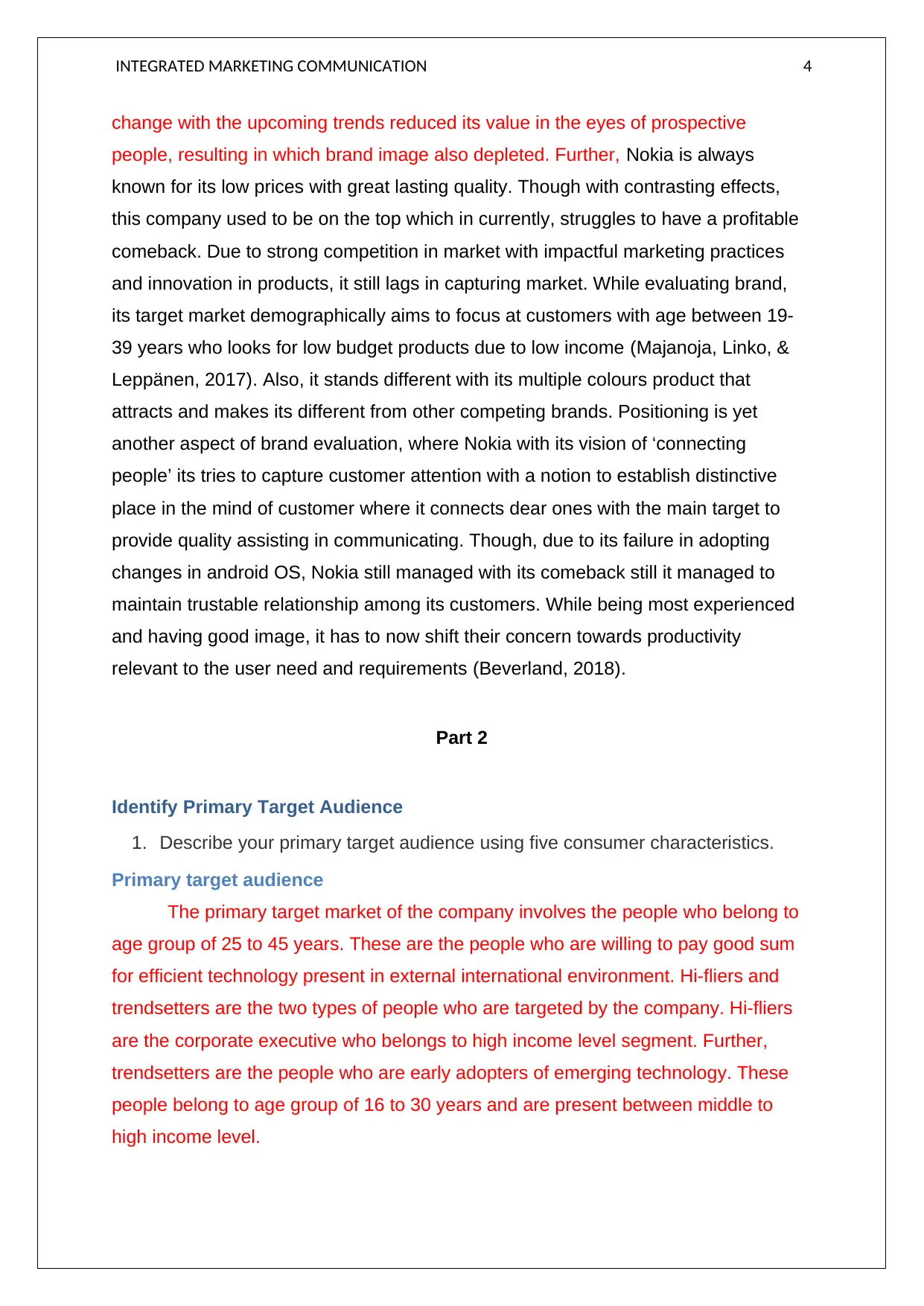
INTEGRATED MARKETING COMMUNICATION 4
change with the upcoming trends reduced its value in the eyes of prospective
people, resulting in which brand image also depleted. Further, Nokia is always
known for its low prices with great lasting quality. Though with contrasting effects,
this company used to be on the top which in currently, struggles to have a profitable
comeback. Due to strong competition in market with impactful marketing practices
and innovation in products, it still lags in capturing market. While evaluating brand,
its target market demographically aims to focus at customers with age between 19-
39 years who looks for low budget products due to low income (Majanoja, Linko, &
Leppänen, 2017). Also, it stands different with its multiple colours product that
attracts and makes its different from other competing brands. Positioning is yet
another aspect of brand evaluation, where Nokia with its vision of ‘connecting
people’ its tries to capture customer attention with a notion to establish distinctive
place in the mind of customer where it connects dear ones with the main target to
provide quality assisting in communicating. Though, due to its failure in adopting
changes in android OS, Nokia still managed with its comeback still it managed to
maintain trustable relationship among its customers. While being most experienced
and having good image, it has to now shift their concern towards productivity
relevant to the user need and requirements (Beverland, 2018).
Part 2
Identify Primary Target Audience
1. Describe your primary target audience using five consumer characteristics.
Primary target audience
The primary target market of the company involves the people who belong to
age group of 25 to 45 years. These are the people who are willing to pay good sum
for efficient technology present in external international environment. Hi-fliers and
trendsetters are the two types of people who are targeted by the company. Hi-fliers
are the corporate executive who belongs to high income level segment. Further,
trendsetters are the people who are early adopters of emerging technology. These
people belong to age group of 16 to 30 years and are present between middle to
high income level.
change with the upcoming trends reduced its value in the eyes of prospective
people, resulting in which brand image also depleted. Further, Nokia is always
known for its low prices with great lasting quality. Though with contrasting effects,
this company used to be on the top which in currently, struggles to have a profitable
comeback. Due to strong competition in market with impactful marketing practices
and innovation in products, it still lags in capturing market. While evaluating brand,
its target market demographically aims to focus at customers with age between 19-
39 years who looks for low budget products due to low income (Majanoja, Linko, &
Leppänen, 2017). Also, it stands different with its multiple colours product that
attracts and makes its different from other competing brands. Positioning is yet
another aspect of brand evaluation, where Nokia with its vision of ‘connecting
people’ its tries to capture customer attention with a notion to establish distinctive
place in the mind of customer where it connects dear ones with the main target to
provide quality assisting in communicating. Though, due to its failure in adopting
changes in android OS, Nokia still managed with its comeback still it managed to
maintain trustable relationship among its customers. While being most experienced
and having good image, it has to now shift their concern towards productivity
relevant to the user need and requirements (Beverland, 2018).
Part 2
Identify Primary Target Audience
1. Describe your primary target audience using five consumer characteristics.
Primary target audience
The primary target market of the company involves the people who belong to
age group of 25 to 45 years. These are the people who are willing to pay good sum
for efficient technology present in external international environment. Hi-fliers and
trendsetters are the two types of people who are targeted by the company. Hi-fliers
are the corporate executive who belongs to high income level segment. Further,
trendsetters are the people who are early adopters of emerging technology. These
people belong to age group of 16 to 30 years and are present between middle to
high income level.
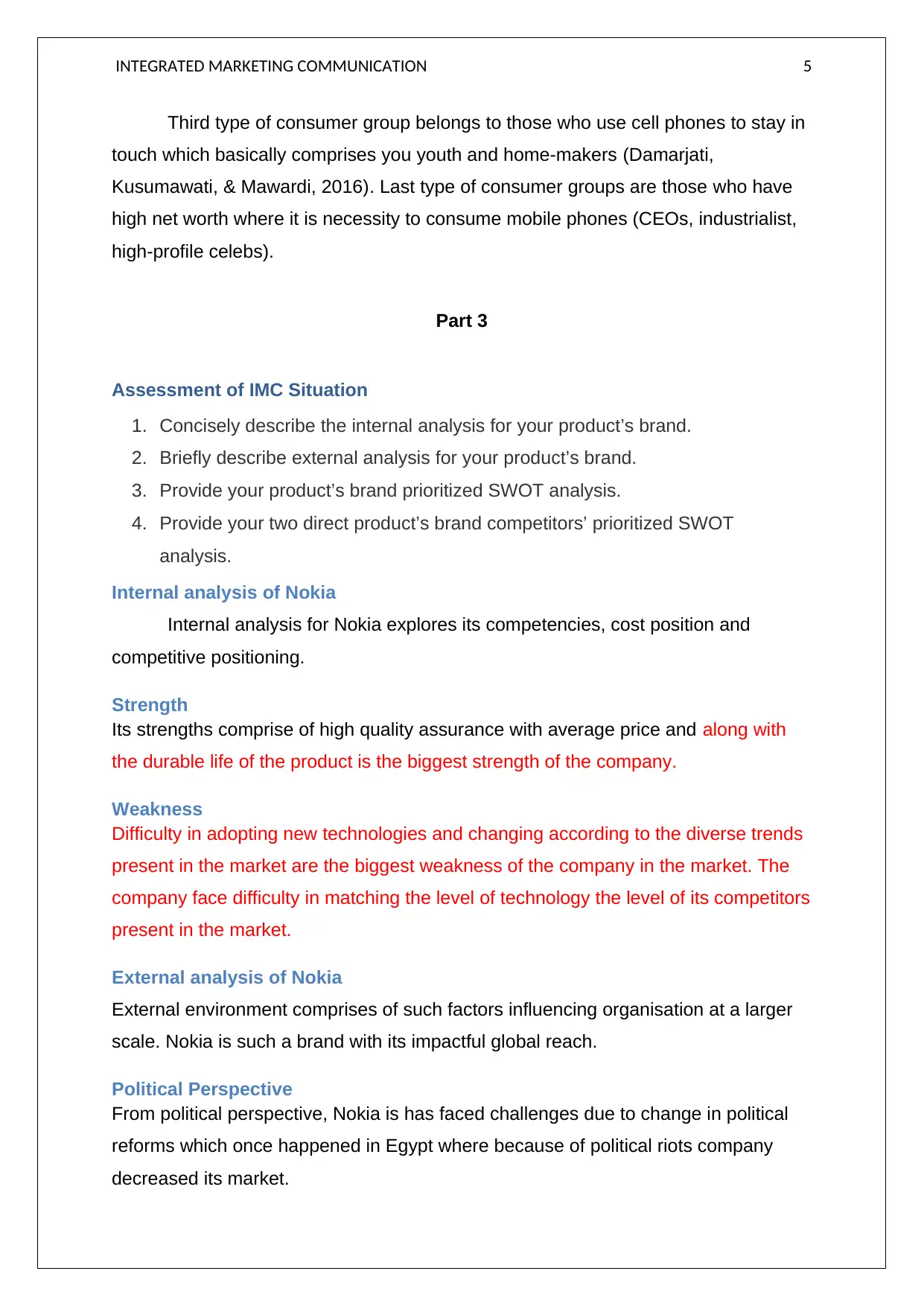
INTEGRATED MARKETING COMMUNICATION 5
Third type of consumer group belongs to those who use cell phones to stay in
touch which basically comprises you youth and home-makers (Damarjati,
Kusumawati, & Mawardi, 2016). Last type of consumer groups are those who have
high net worth where it is necessity to consume mobile phones (CEOs, industrialist,
high-profile celebs).
Part 3
Assessment of IMC Situation
1. Concisely describe the internal analysis for your product’s brand.
2. Briefly describe external analysis for your product’s brand.
3. Provide your product’s brand prioritized SWOT analysis.
4. Provide your two direct product’s brand competitors’ prioritized SWOT
analysis.
Internal analysis of Nokia
Internal analysis for Nokia explores its competencies, cost position and
competitive positioning.
Strength
Its strengths comprise of high quality assurance with average price and along with
the durable life of the product is the biggest strength of the company.
Weakness
Difficulty in adopting new technologies and changing according to the diverse trends
present in the market are the biggest weakness of the company in the market. The
company face difficulty in matching the level of technology the level of its competitors
present in the market.
External analysis of Nokia
External environment comprises of such factors influencing organisation at a larger
scale. Nokia is such a brand with its impactful global reach.
Political Perspective
From political perspective, Nokia is has faced challenges due to change in political
reforms which once happened in Egypt where because of political riots company
decreased its market.
Third type of consumer group belongs to those who use cell phones to stay in
touch which basically comprises you youth and home-makers (Damarjati,
Kusumawati, & Mawardi, 2016). Last type of consumer groups are those who have
high net worth where it is necessity to consume mobile phones (CEOs, industrialist,
high-profile celebs).
Part 3
Assessment of IMC Situation
1. Concisely describe the internal analysis for your product’s brand.
2. Briefly describe external analysis for your product’s brand.
3. Provide your product’s brand prioritized SWOT analysis.
4. Provide your two direct product’s brand competitors’ prioritized SWOT
analysis.
Internal analysis of Nokia
Internal analysis for Nokia explores its competencies, cost position and
competitive positioning.
Strength
Its strengths comprise of high quality assurance with average price and along with
the durable life of the product is the biggest strength of the company.
Weakness
Difficulty in adopting new technologies and changing according to the diverse trends
present in the market are the biggest weakness of the company in the market. The
company face difficulty in matching the level of technology the level of its competitors
present in the market.
External analysis of Nokia
External environment comprises of such factors influencing organisation at a larger
scale. Nokia is such a brand with its impactful global reach.
Political Perspective
From political perspective, Nokia is has faced challenges due to change in political
reforms which once happened in Egypt where because of political riots company
decreased its market.
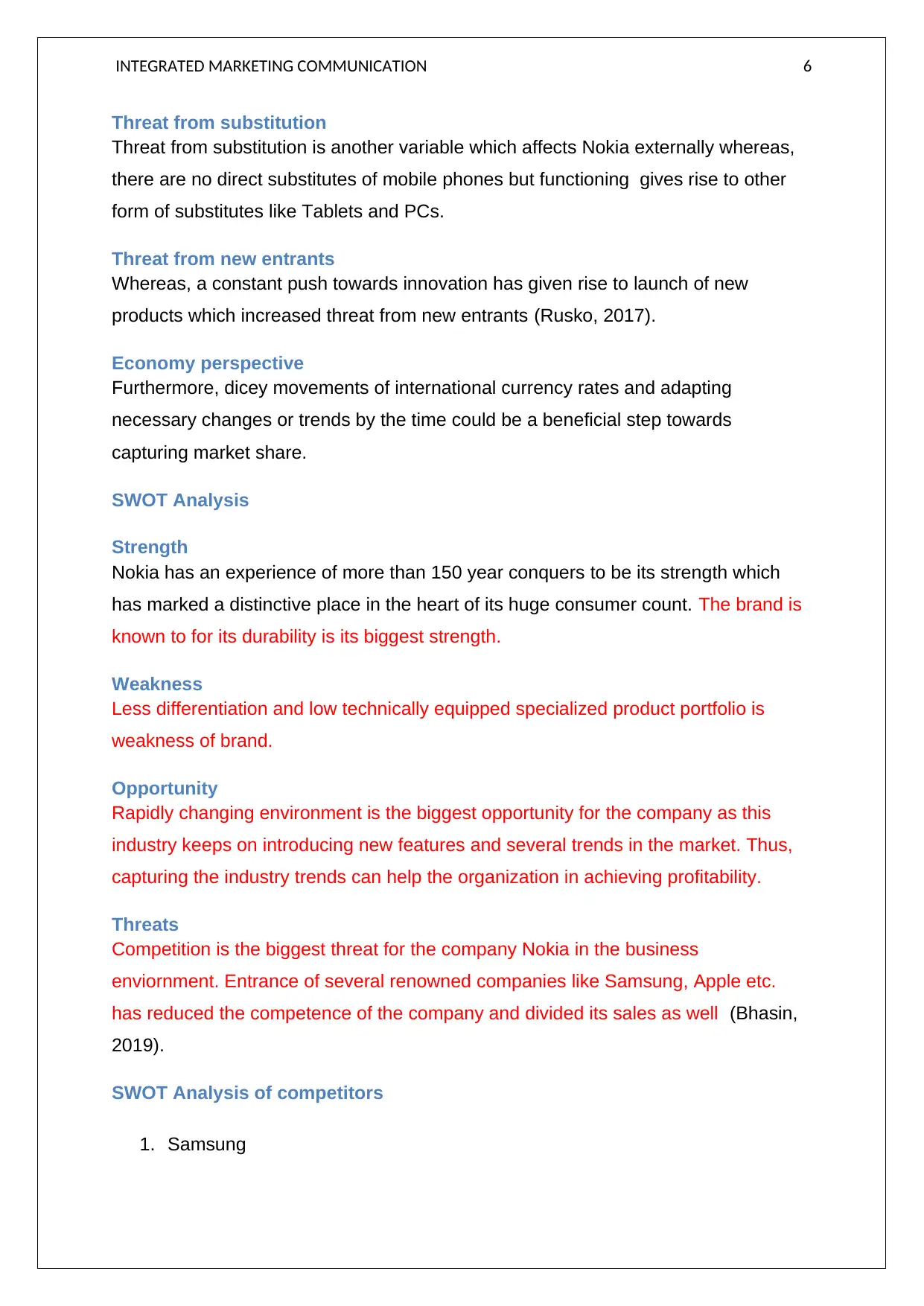
INTEGRATED MARKETING COMMUNICATION 6
Threat from substitution
Threat from substitution is another variable which affects Nokia externally whereas,
there are no direct substitutes of mobile phones but functioning gives rise to other
form of substitutes like Tablets and PCs.
Threat from new entrants
Whereas, a constant push towards innovation has given rise to launch of new
products which increased threat from new entrants (Rusko, 2017).
Economy perspective
Furthermore, dicey movements of international currency rates and adapting
necessary changes or trends by the time could be a beneficial step towards
capturing market share.
SWOT Analysis
Strength
Nokia has an experience of more than 150 year conquers to be its strength which
has marked a distinctive place in the heart of its huge consumer count. The brand is
known to for its durability is its biggest strength.
Weakness
Less differentiation and low technically equipped specialized product portfolio is
weakness of brand.
Opportunity
Rapidly changing environment is the biggest opportunity for the company as this
industry keeps on introducing new features and several trends in the market. Thus,
capturing the industry trends can help the organization in achieving profitability.
Threats
Competition is the biggest threat for the company Nokia in the business
enviornment. Entrance of several renowned companies like Samsung, Apple etc.
has reduced the competence of the company and divided its sales as well (Bhasin,
2019).
SWOT Analysis of competitors
1. Samsung
Threat from substitution
Threat from substitution is another variable which affects Nokia externally whereas,
there are no direct substitutes of mobile phones but functioning gives rise to other
form of substitutes like Tablets and PCs.
Threat from new entrants
Whereas, a constant push towards innovation has given rise to launch of new
products which increased threat from new entrants (Rusko, 2017).
Economy perspective
Furthermore, dicey movements of international currency rates and adapting
necessary changes or trends by the time could be a beneficial step towards
capturing market share.
SWOT Analysis
Strength
Nokia has an experience of more than 150 year conquers to be its strength which
has marked a distinctive place in the heart of its huge consumer count. The brand is
known to for its durability is its biggest strength.
Weakness
Less differentiation and low technically equipped specialized product portfolio is
weakness of brand.
Opportunity
Rapidly changing environment is the biggest opportunity for the company as this
industry keeps on introducing new features and several trends in the market. Thus,
capturing the industry trends can help the organization in achieving profitability.
Threats
Competition is the biggest threat for the company Nokia in the business
enviornment. Entrance of several renowned companies like Samsung, Apple etc.
has reduced the competence of the company and divided its sales as well (Bhasin,
2019).
SWOT Analysis of competitors
1. Samsung
Paraphrase This Document
Need a fresh take? Get an instant paraphrase of this document with our AI Paraphraser
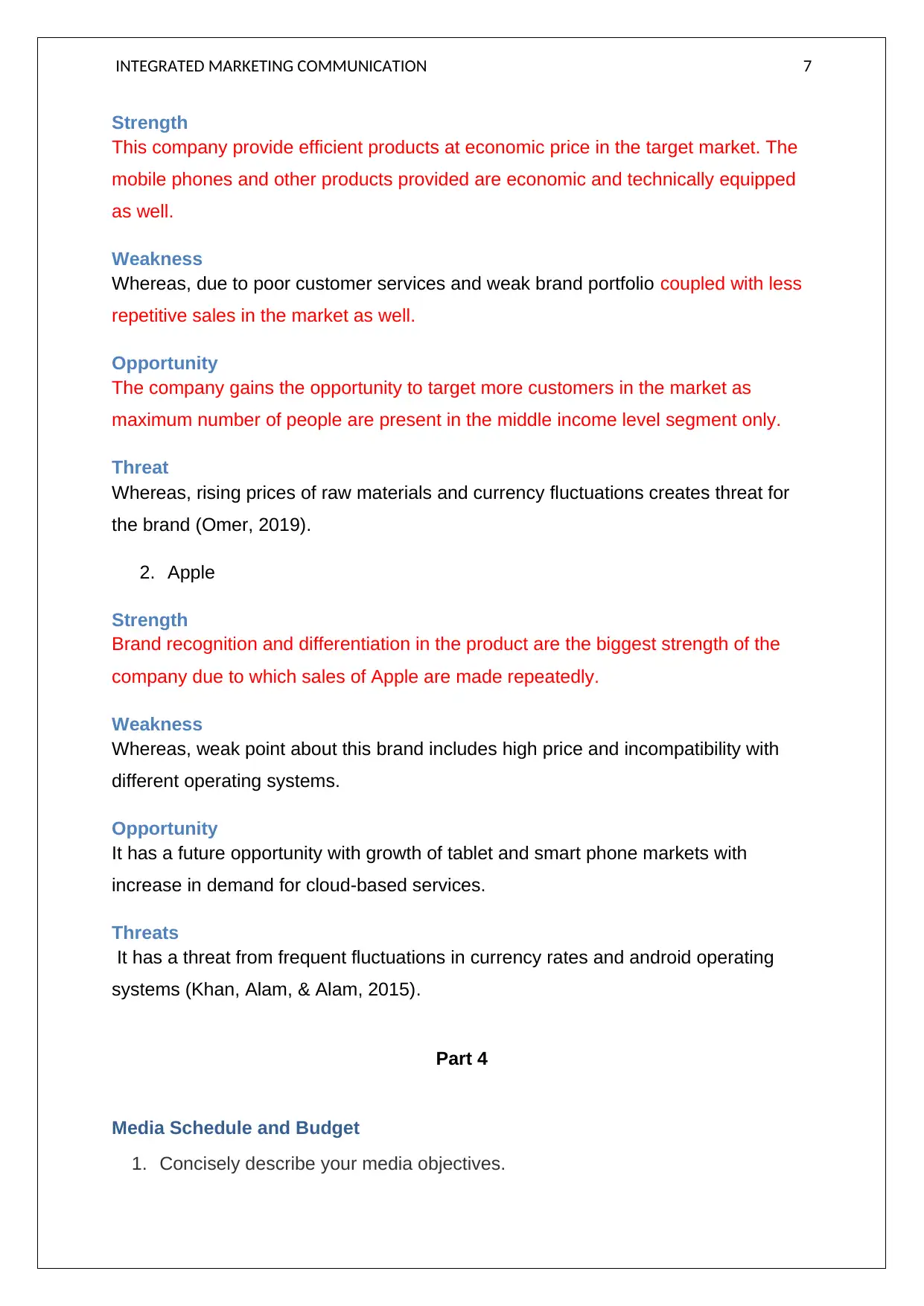
INTEGRATED MARKETING COMMUNICATION 7
Strength
This company provide efficient products at economic price in the target market. The
mobile phones and other products provided are economic and technically equipped
as well.
Weakness
Whereas, due to poor customer services and weak brand portfolio coupled with less
repetitive sales in the market as well.
Opportunity
The company gains the opportunity to target more customers in the market as
maximum number of people are present in the middle income level segment only.
Threat
Whereas, rising prices of raw materials and currency fluctuations creates threat for
the brand (Omer, 2019).
2. Apple
Strength
Brand recognition and differentiation in the product are the biggest strength of the
company due to which sales of Apple are made repeatedly.
Weakness
Whereas, weak point about this brand includes high price and incompatibility with
different operating systems.
Opportunity
It has a future opportunity with growth of tablet and smart phone markets with
increase in demand for cloud-based services.
Threats
It has a threat from frequent fluctuations in currency rates and android operating
systems (Khan, Alam, & Alam, 2015).
Part 4
Media Schedule and Budget
1. Concisely describe your media objectives.
Strength
This company provide efficient products at economic price in the target market. The
mobile phones and other products provided are economic and technically equipped
as well.
Weakness
Whereas, due to poor customer services and weak brand portfolio coupled with less
repetitive sales in the market as well.
Opportunity
The company gains the opportunity to target more customers in the market as
maximum number of people are present in the middle income level segment only.
Threat
Whereas, rising prices of raw materials and currency fluctuations creates threat for
the brand (Omer, 2019).
2. Apple
Strength
Brand recognition and differentiation in the product are the biggest strength of the
company due to which sales of Apple are made repeatedly.
Weakness
Whereas, weak point about this brand includes high price and incompatibility with
different operating systems.
Opportunity
It has a future opportunity with growth of tablet and smart phone markets with
increase in demand for cloud-based services.
Threats
It has a threat from frequent fluctuations in currency rates and android operating
systems (Khan, Alam, & Alam, 2015).
Part 4
Media Schedule and Budget
1. Concisely describe your media objectives.
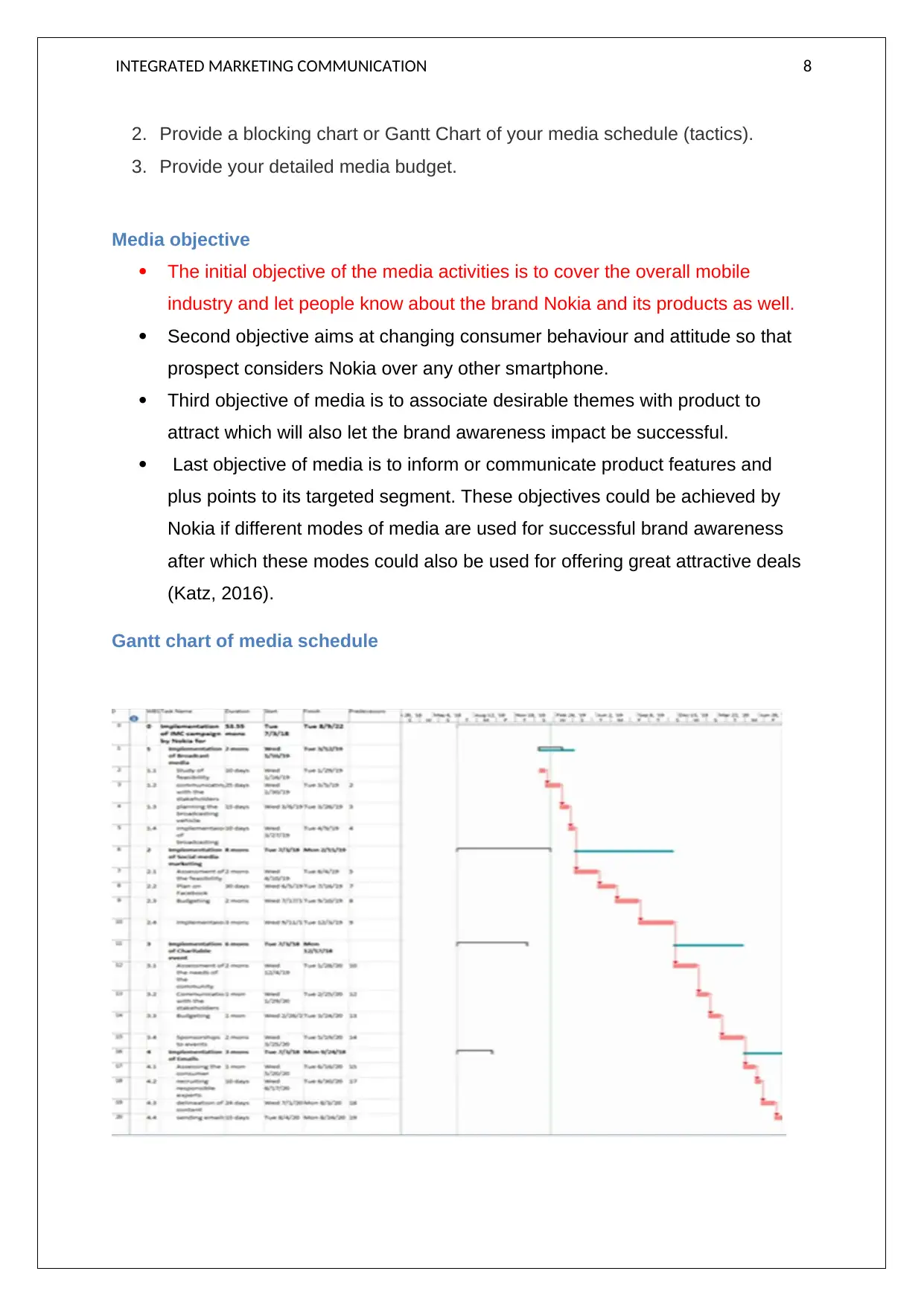
INTEGRATED MARKETING COMMUNICATION 8
2. Provide a blocking chart or Gantt Chart of your media schedule (tactics).
3. Provide your detailed media budget.
Media objective
The initial objective of the media activities is to cover the overall mobile
industry and let people know about the brand Nokia and its products as well.
Second objective aims at changing consumer behaviour and attitude so that
prospect considers Nokia over any other smartphone.
Third objective of media is to associate desirable themes with product to
attract which will also let the brand awareness impact be successful.
Last objective of media is to inform or communicate product features and
plus points to its targeted segment. These objectives could be achieved by
Nokia if different modes of media are used for successful brand awareness
after which these modes could also be used for offering great attractive deals
(Katz, 2016).
Gantt chart of media schedule
2. Provide a blocking chart or Gantt Chart of your media schedule (tactics).
3. Provide your detailed media budget.
Media objective
The initial objective of the media activities is to cover the overall mobile
industry and let people know about the brand Nokia and its products as well.
Second objective aims at changing consumer behaviour and attitude so that
prospect considers Nokia over any other smartphone.
Third objective of media is to associate desirable themes with product to
attract which will also let the brand awareness impact be successful.
Last objective of media is to inform or communicate product features and
plus points to its targeted segment. These objectives could be achieved by
Nokia if different modes of media are used for successful brand awareness
after which these modes could also be used for offering great attractive deals
(Katz, 2016).
Gantt chart of media schedule
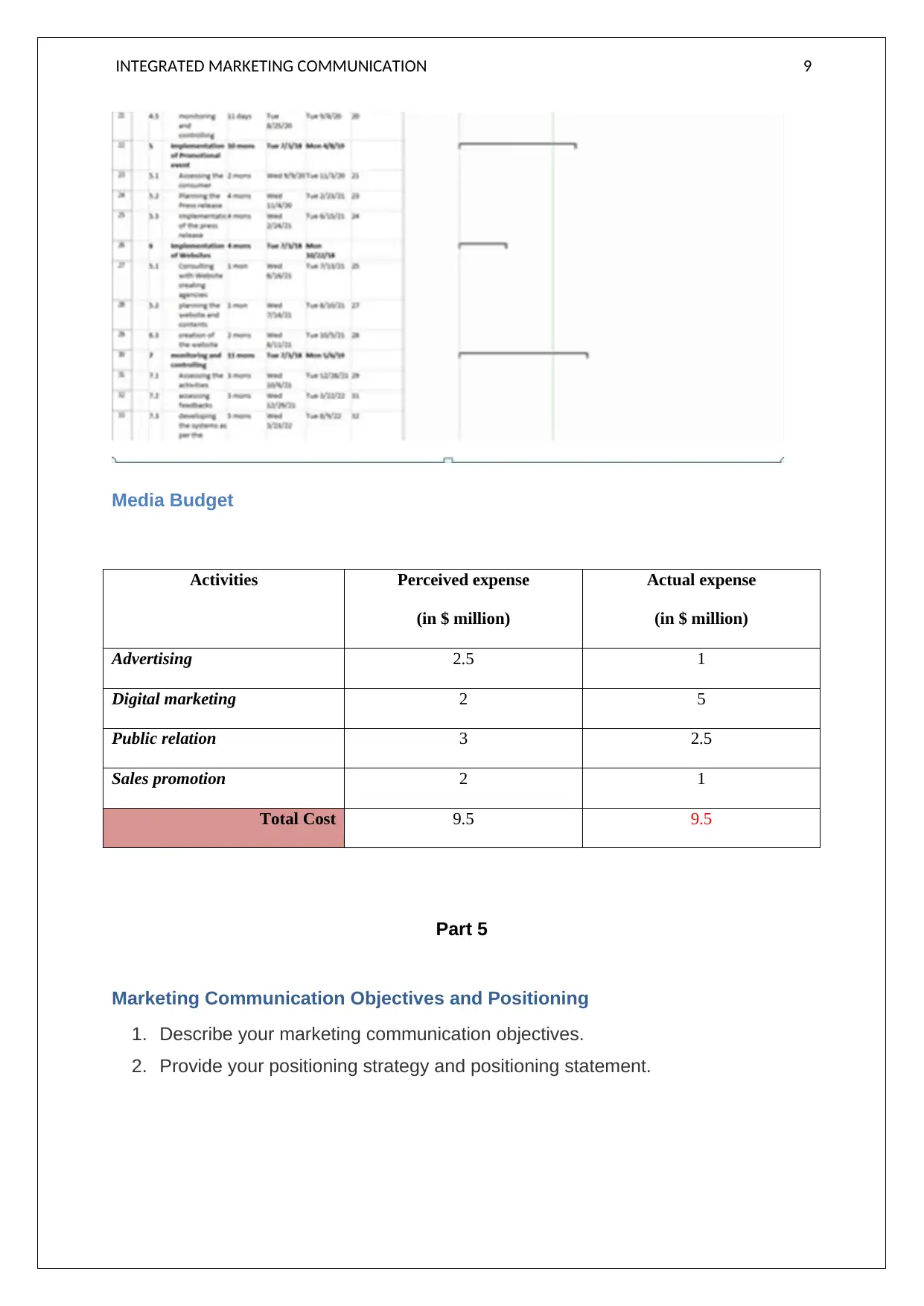
INTEGRATED MARKETING COMMUNICATION 9
Media Budget
Activities Perceived expense
(in $ million)
Actual expense
(in $ million)
Advertising 2.5 1
Digital marketing 2 5
Public relation 3 2.5
Sales promotion 2 1
Total Cost 9.5 9.5
Part 5
Marketing Communication Objectives and Positioning
1. Describe your marketing communication objectives.
2. Provide your positioning strategy and positioning statement.
Media Budget
Activities Perceived expense
(in $ million)
Actual expense
(in $ million)
Advertising 2.5 1
Digital marketing 2 5
Public relation 3 2.5
Sales promotion 2 1
Total Cost 9.5 9.5
Part 5
Marketing Communication Objectives and Positioning
1. Describe your marketing communication objectives.
2. Provide your positioning strategy and positioning statement.
Secure Best Marks with AI Grader
Need help grading? Try our AI Grader for instant feedback on your assignments.
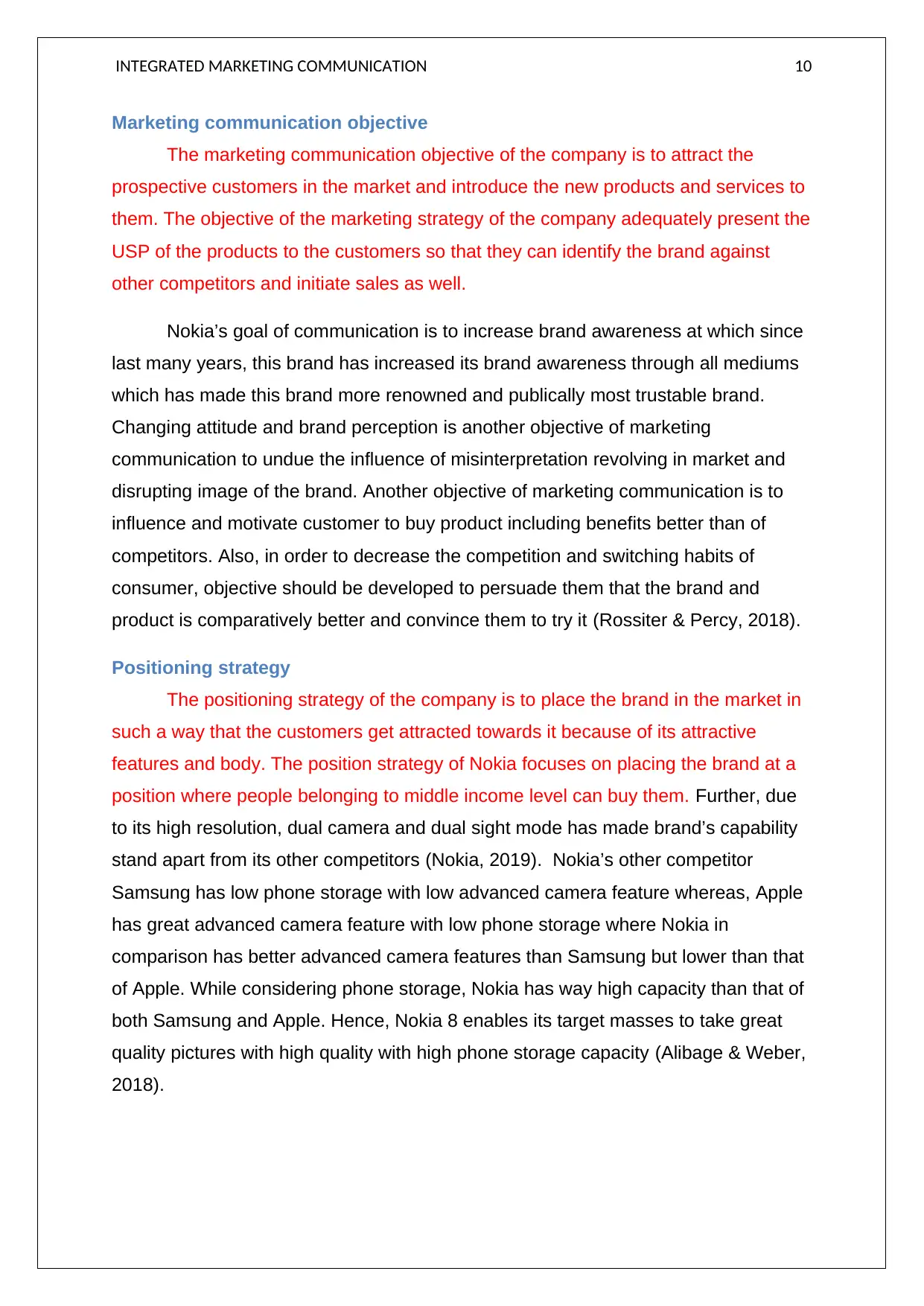
INTEGRATED MARKETING COMMUNICATION 10
Marketing communication objective
The marketing communication objective of the company is to attract the
prospective customers in the market and introduce the new products and services to
them. The objective of the marketing strategy of the company adequately present the
USP of the products to the customers so that they can identify the brand against
other competitors and initiate sales as well.
Nokia’s goal of communication is to increase brand awareness at which since
last many years, this brand has increased its brand awareness through all mediums
which has made this brand more renowned and publically most trustable brand.
Changing attitude and brand perception is another objective of marketing
communication to undue the influence of misinterpretation revolving in market and
disrupting image of the brand. Another objective of marketing communication is to
influence and motivate customer to buy product including benefits better than of
competitors. Also, in order to decrease the competition and switching habits of
consumer, objective should be developed to persuade them that the brand and
product is comparatively better and convince them to try it (Rossiter & Percy, 2018).
Positioning strategy
The positioning strategy of the company is to place the brand in the market in
such a way that the customers get attracted towards it because of its attractive
features and body. The position strategy of Nokia focuses on placing the brand at a
position where people belonging to middle income level can buy them. Further, due
to its high resolution, dual camera and dual sight mode has made brand’s capability
stand apart from its other competitors (Nokia, 2019). Nokia’s other competitor
Samsung has low phone storage with low advanced camera feature whereas, Apple
has great advanced camera feature with low phone storage where Nokia in
comparison has better advanced camera features than Samsung but lower than that
of Apple. While considering phone storage, Nokia has way high capacity than that of
both Samsung and Apple. Hence, Nokia 8 enables its target masses to take great
quality pictures with high quality with high phone storage capacity (Alibage & Weber,
2018).
Marketing communication objective
The marketing communication objective of the company is to attract the
prospective customers in the market and introduce the new products and services to
them. The objective of the marketing strategy of the company adequately present the
USP of the products to the customers so that they can identify the brand against
other competitors and initiate sales as well.
Nokia’s goal of communication is to increase brand awareness at which since
last many years, this brand has increased its brand awareness through all mediums
which has made this brand more renowned and publically most trustable brand.
Changing attitude and brand perception is another objective of marketing
communication to undue the influence of misinterpretation revolving in market and
disrupting image of the brand. Another objective of marketing communication is to
influence and motivate customer to buy product including benefits better than of
competitors. Also, in order to decrease the competition and switching habits of
consumer, objective should be developed to persuade them that the brand and
product is comparatively better and convince them to try it (Rossiter & Percy, 2018).
Positioning strategy
The positioning strategy of the company is to place the brand in the market in
such a way that the customers get attracted towards it because of its attractive
features and body. The position strategy of Nokia focuses on placing the brand at a
position where people belonging to middle income level can buy them. Further, due
to its high resolution, dual camera and dual sight mode has made brand’s capability
stand apart from its other competitors (Nokia, 2019). Nokia’s other competitor
Samsung has low phone storage with low advanced camera feature whereas, Apple
has great advanced camera feature with low phone storage where Nokia in
comparison has better advanced camera features than Samsung but lower than that
of Apple. While considering phone storage, Nokia has way high capacity than that of
both Samsung and Apple. Hence, Nokia 8 enables its target masses to take great
quality pictures with high quality with high phone storage capacity (Alibage & Weber,
2018).
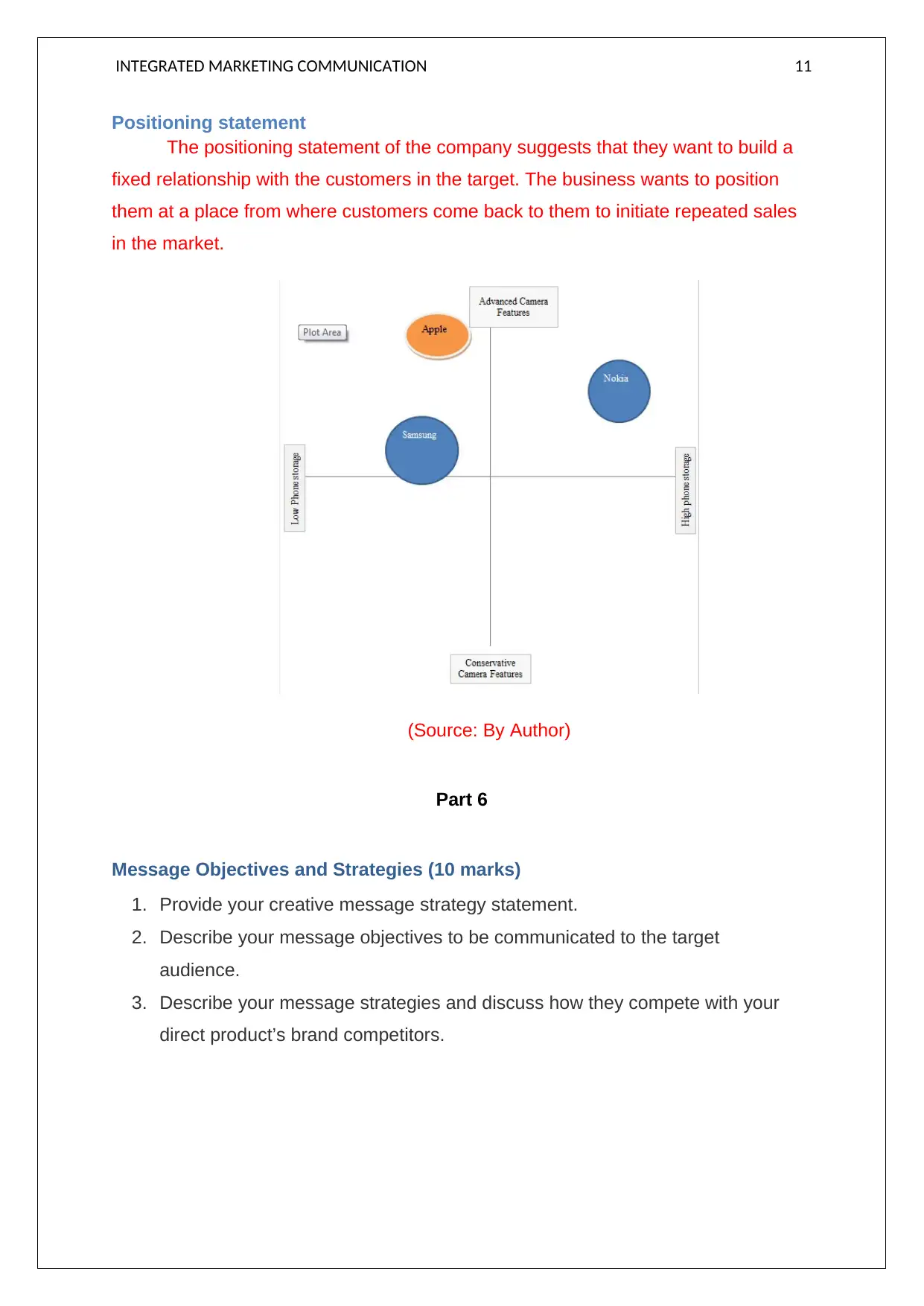
INTEGRATED MARKETING COMMUNICATION 11
Positioning statement
The positioning statement of the company suggests that they want to build a
fixed relationship with the customers in the target. The business wants to position
them at a place from where customers come back to them to initiate repeated sales
in the market.
(Source: By Author)
Part 6
Message Objectives and Strategies (10 marks)
1. Provide your creative message strategy statement.
2. Describe your message objectives to be communicated to the target
audience.
3. Describe your message strategies and discuss how they compete with your
direct product’s brand competitors.
Positioning statement
The positioning statement of the company suggests that they want to build a
fixed relationship with the customers in the target. The business wants to position
them at a place from where customers come back to them to initiate repeated sales
in the market.
(Source: By Author)
Part 6
Message Objectives and Strategies (10 marks)
1. Provide your creative message strategy statement.
2. Describe your message objectives to be communicated to the target
audience.
3. Describe your message strategies and discuss how they compete with your
direct product’s brand competitors.
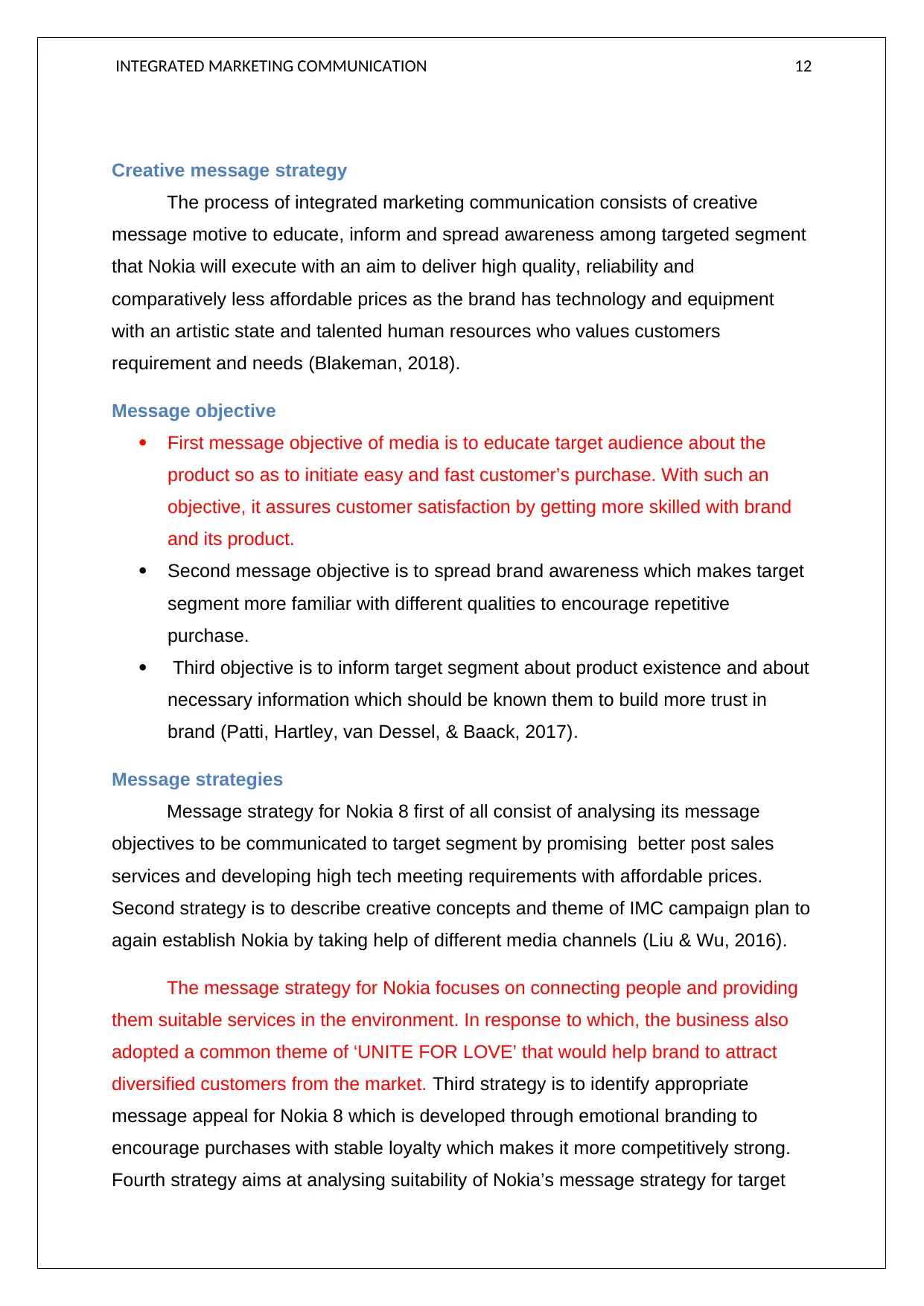
INTEGRATED MARKETING COMMUNICATION 12
Creative message strategy
The process of integrated marketing communication consists of creative
message motive to educate, inform and spread awareness among targeted segment
that Nokia will execute with an aim to deliver high quality, reliability and
comparatively less affordable prices as the brand has technology and equipment
with an artistic state and talented human resources who values customers
requirement and needs (Blakeman, 2018).
Message objective
First message objective of media is to educate target audience about the
product so as to initiate easy and fast customer’s purchase. With such an
objective, it assures customer satisfaction by getting more skilled with brand
and its product.
Second message objective is to spread brand awareness which makes target
segment more familiar with different qualities to encourage repetitive
purchase.
Third objective is to inform target segment about product existence and about
necessary information which should be known them to build more trust in
brand (Patti, Hartley, van Dessel, & Baack, 2017).
Message strategies
Message strategy for Nokia 8 first of all consist of analysing its message
objectives to be communicated to target segment by promising better post sales
services and developing high tech meeting requirements with affordable prices.
Second strategy is to describe creative concepts and theme of IMC campaign plan to
again establish Nokia by taking help of different media channels (Liu & Wu, 2016).
The message strategy for Nokia focuses on connecting people and providing
them suitable services in the environment. In response to which, the business also
adopted a common theme of ‘UNITE FOR LOVE’ that would help brand to attract
diversified customers from the market. Third strategy is to identify appropriate
message appeal for Nokia 8 which is developed through emotional branding to
encourage purchases with stable loyalty which makes it more competitively strong.
Fourth strategy aims at analysing suitability of Nokia’s message strategy for target
Creative message strategy
The process of integrated marketing communication consists of creative
message motive to educate, inform and spread awareness among targeted segment
that Nokia will execute with an aim to deliver high quality, reliability and
comparatively less affordable prices as the brand has technology and equipment
with an artistic state and talented human resources who values customers
requirement and needs (Blakeman, 2018).
Message objective
First message objective of media is to educate target audience about the
product so as to initiate easy and fast customer’s purchase. With such an
objective, it assures customer satisfaction by getting more skilled with brand
and its product.
Second message objective is to spread brand awareness which makes target
segment more familiar with different qualities to encourage repetitive
purchase.
Third objective is to inform target segment about product existence and about
necessary information which should be known them to build more trust in
brand (Patti, Hartley, van Dessel, & Baack, 2017).
Message strategies
Message strategy for Nokia 8 first of all consist of analysing its message
objectives to be communicated to target segment by promising better post sales
services and developing high tech meeting requirements with affordable prices.
Second strategy is to describe creative concepts and theme of IMC campaign plan to
again establish Nokia by taking help of different media channels (Liu & Wu, 2016).
The message strategy for Nokia focuses on connecting people and providing
them suitable services in the environment. In response to which, the business also
adopted a common theme of ‘UNITE FOR LOVE’ that would help brand to attract
diversified customers from the market. Third strategy is to identify appropriate
message appeal for Nokia 8 which is developed through emotional branding to
encourage purchases with stable loyalty which makes it more competitively strong.
Fourth strategy aims at analysing suitability of Nokia’s message strategy for target
Paraphrase This Document
Need a fresh take? Get an instant paraphrase of this document with our AI Paraphraser
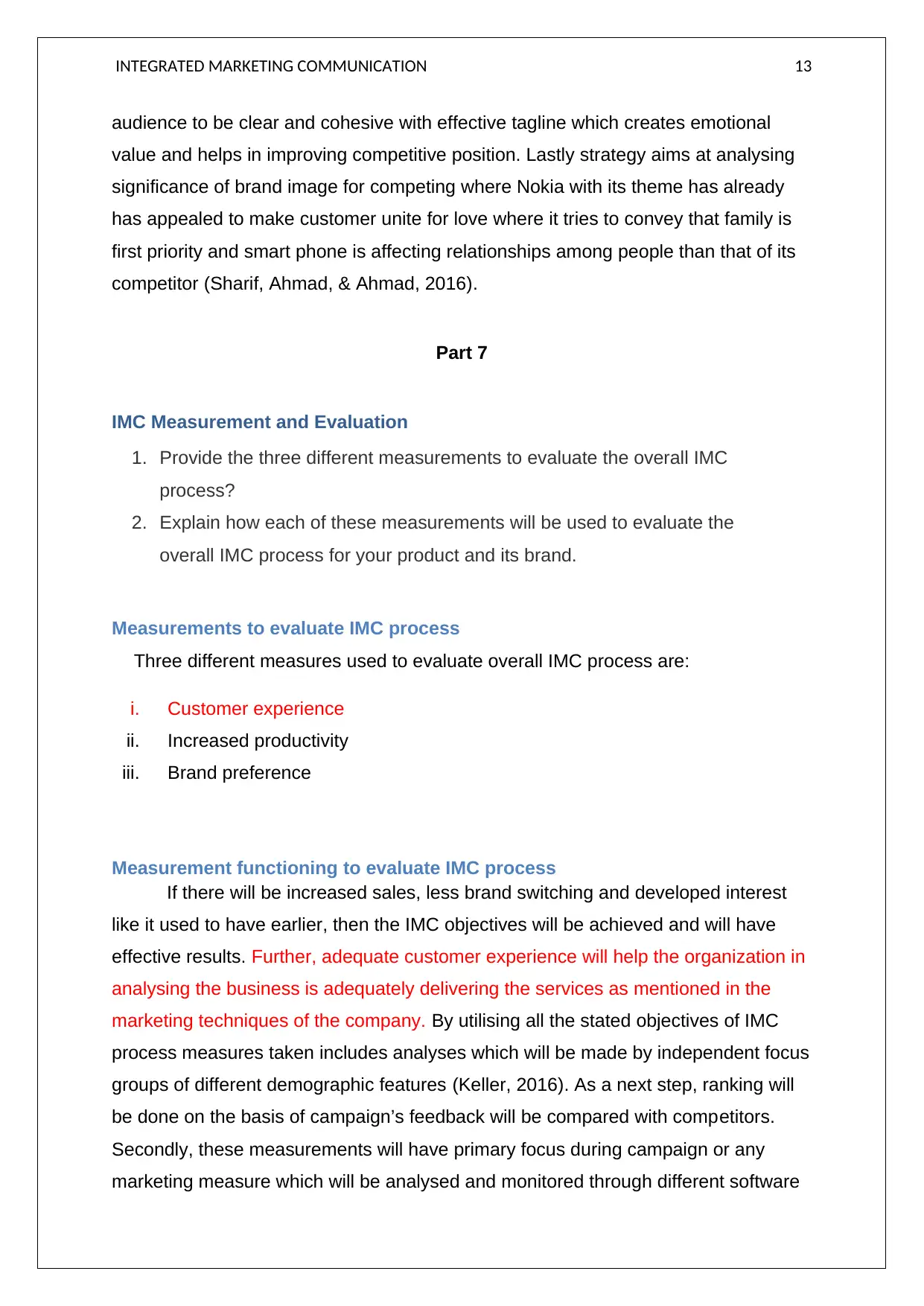
INTEGRATED MARKETING COMMUNICATION 13
audience to be clear and cohesive with effective tagline which creates emotional
value and helps in improving competitive position. Lastly strategy aims at analysing
significance of brand image for competing where Nokia with its theme has already
has appealed to make customer unite for love where it tries to convey that family is
first priority and smart phone is affecting relationships among people than that of its
competitor (Sharif, Ahmad, & Ahmad, 2016).
Part 7
IMC Measurement and Evaluation
1. Provide the three different measurements to evaluate the overall IMC
process?
2. Explain how each of these measurements will be used to evaluate the
overall IMC process for your product and its brand.
Measurements to evaluate IMC process
Three different measures used to evaluate overall IMC process are:
i. Customer experience
ii. Increased productivity
iii. Brand preference
Measurement functioning to evaluate IMC process
If there will be increased sales, less brand switching and developed interest
like it used to have earlier, then the IMC objectives will be achieved and will have
effective results. Further, adequate customer experience will help the organization in
analysing the business is adequately delivering the services as mentioned in the
marketing techniques of the company. By utilising all the stated objectives of IMC
process measures taken includes analyses which will be made by independent focus
groups of different demographic features (Keller, 2016). As a next step, ranking will
be done on the basis of campaign’s feedback will be compared with competitors.
Secondly, these measurements will have primary focus during campaign or any
marketing measure which will be analysed and monitored through different software
audience to be clear and cohesive with effective tagline which creates emotional
value and helps in improving competitive position. Lastly strategy aims at analysing
significance of brand image for competing where Nokia with its theme has already
has appealed to make customer unite for love where it tries to convey that family is
first priority and smart phone is affecting relationships among people than that of its
competitor (Sharif, Ahmad, & Ahmad, 2016).
Part 7
IMC Measurement and Evaluation
1. Provide the three different measurements to evaluate the overall IMC
process?
2. Explain how each of these measurements will be used to evaluate the
overall IMC process for your product and its brand.
Measurements to evaluate IMC process
Three different measures used to evaluate overall IMC process are:
i. Customer experience
ii. Increased productivity
iii. Brand preference
Measurement functioning to evaluate IMC process
If there will be increased sales, less brand switching and developed interest
like it used to have earlier, then the IMC objectives will be achieved and will have
effective results. Further, adequate customer experience will help the organization in
analysing the business is adequately delivering the services as mentioned in the
marketing techniques of the company. By utilising all the stated objectives of IMC
process measures taken includes analyses which will be made by independent focus
groups of different demographic features (Keller, 2016). As a next step, ranking will
be done on the basis of campaign’s feedback will be compared with competitors.
Secondly, these measurements will have primary focus during campaign or any
marketing measure which will be analysed and monitored through different software
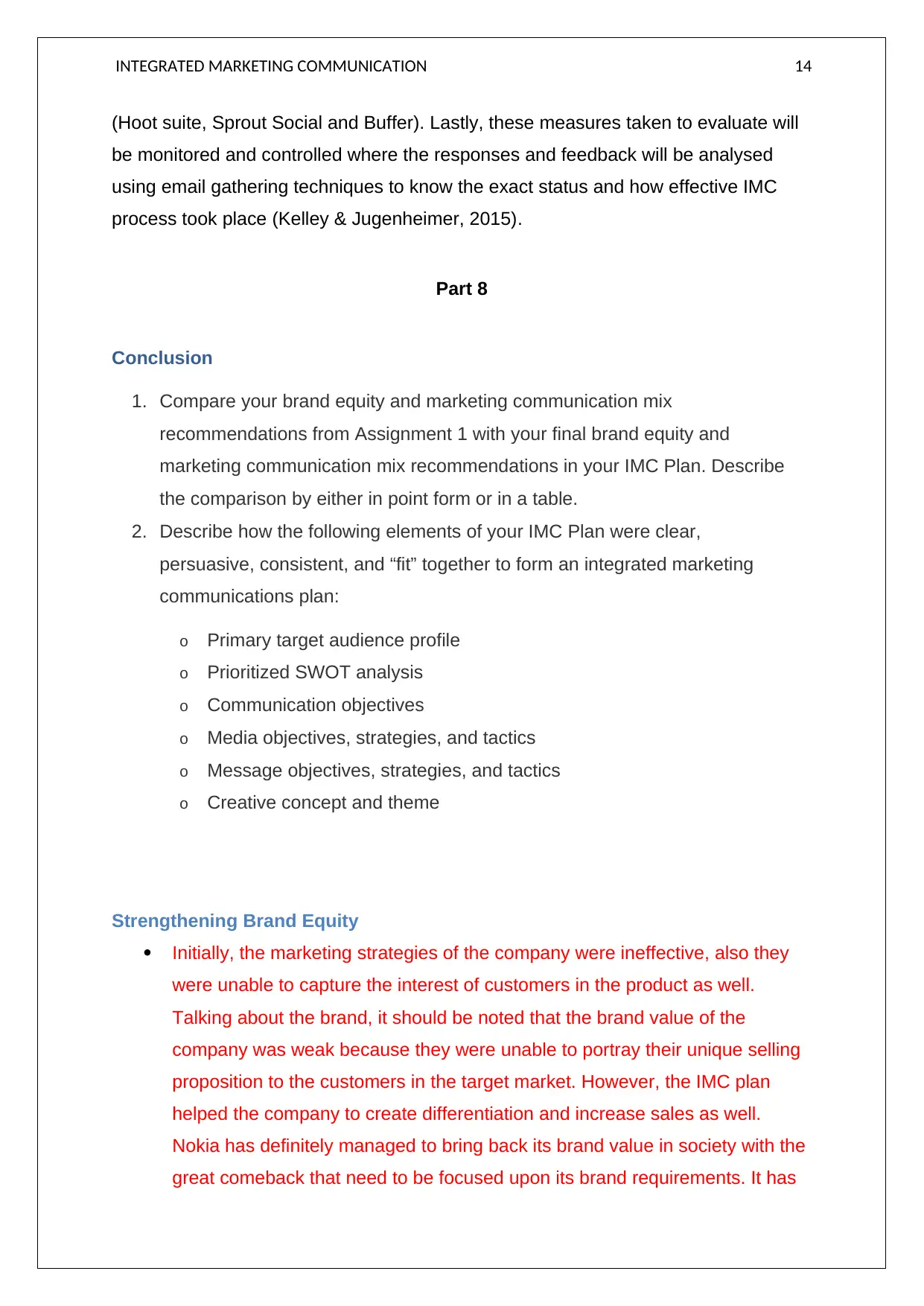
INTEGRATED MARKETING COMMUNICATION 14
(Hoot suite, Sprout Social and Buffer). Lastly, these measures taken to evaluate will
be monitored and controlled where the responses and feedback will be analysed
using email gathering techniques to know the exact status and how effective IMC
process took place (Kelley & Jugenheimer, 2015).
Part 8
Conclusion
1. Compare your brand equity and marketing communication mix
recommendations from Assignment 1 with your final brand equity and
marketing communication mix recommendations in your IMC Plan. Describe
the comparison by either in point form or in a table.
2. Describe how the following elements of your IMC Plan were clear,
persuasive, consistent, and “fit” together to form an integrated marketing
communications plan:
o Primary target audience profile
o Prioritized SWOT analysis
o Communication objectives
o Media objectives, strategies, and tactics
o Message objectives, strategies, and tactics
o Creative concept and theme
Strengthening Brand Equity
Initially, the marketing strategies of the company were ineffective, also they
were unable to capture the interest of customers in the product as well.
Talking about the brand, it should be noted that the brand value of the
company was weak because they were unable to portray their unique selling
proposition to the customers in the target market. However, the IMC plan
helped the company to create differentiation and increase sales as well.
Nokia has definitely managed to bring back its brand value in society with the
great comeback that need to be focused upon its brand requirements. It has
(Hoot suite, Sprout Social and Buffer). Lastly, these measures taken to evaluate will
be monitored and controlled where the responses and feedback will be analysed
using email gathering techniques to know the exact status and how effective IMC
process took place (Kelley & Jugenheimer, 2015).
Part 8
Conclusion
1. Compare your brand equity and marketing communication mix
recommendations from Assignment 1 with your final brand equity and
marketing communication mix recommendations in your IMC Plan. Describe
the comparison by either in point form or in a table.
2. Describe how the following elements of your IMC Plan were clear,
persuasive, consistent, and “fit” together to form an integrated marketing
communications plan:
o Primary target audience profile
o Prioritized SWOT analysis
o Communication objectives
o Media objectives, strategies, and tactics
o Message objectives, strategies, and tactics
o Creative concept and theme
Strengthening Brand Equity
Initially, the marketing strategies of the company were ineffective, also they
were unable to capture the interest of customers in the product as well.
Talking about the brand, it should be noted that the brand value of the
company was weak because they were unable to portray their unique selling
proposition to the customers in the target market. However, the IMC plan
helped the company to create differentiation and increase sales as well.
Nokia has definitely managed to bring back its brand value in society with the
great comeback that need to be focused upon its brand requirements. It has
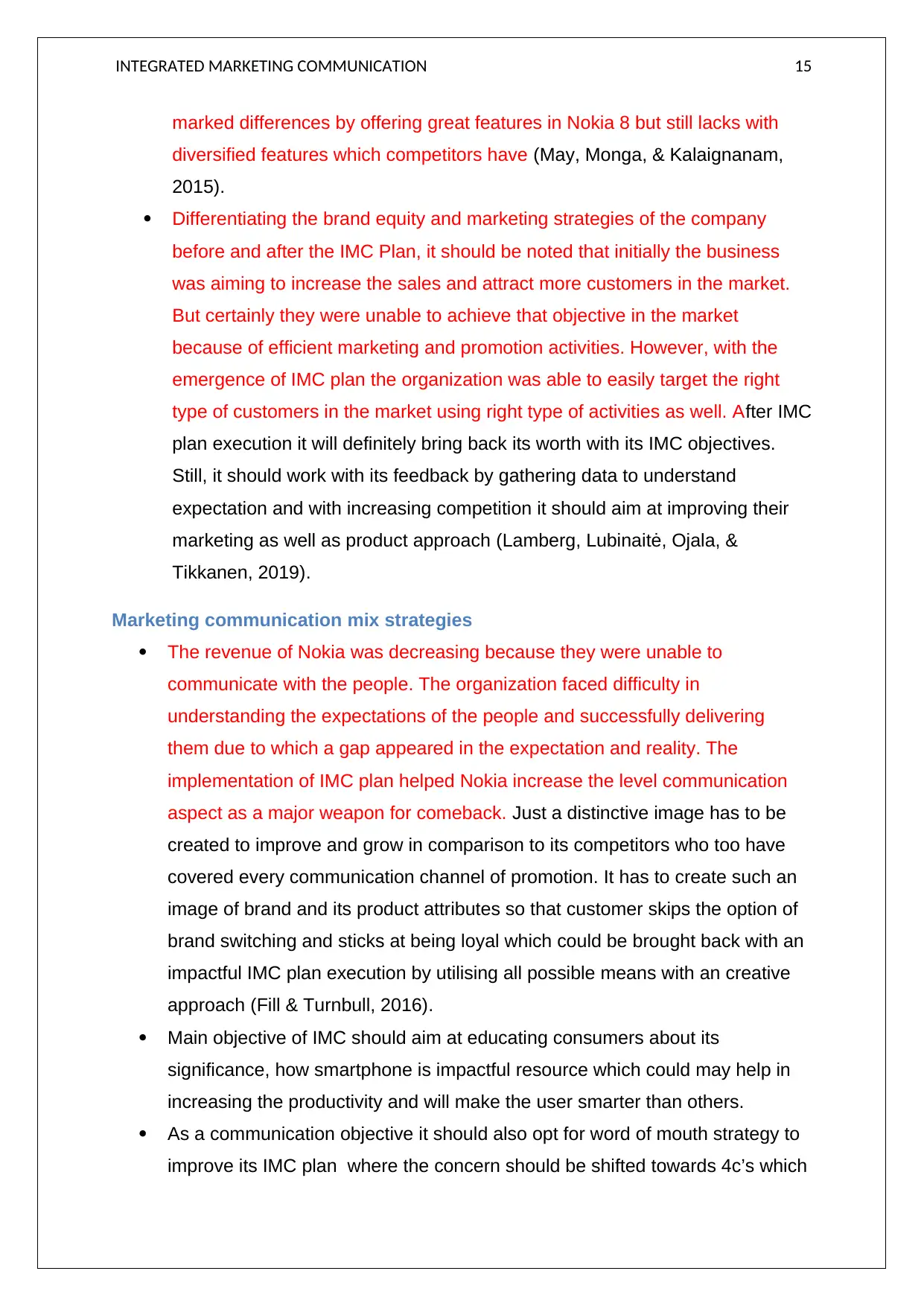
INTEGRATED MARKETING COMMUNICATION 15
marked differences by offering great features in Nokia 8 but still lacks with
diversified features which competitors have (May, Monga, & Kalaignanam,
2015).
Differentiating the brand equity and marketing strategies of the company
before and after the IMC Plan, it should be noted that initially the business
was aiming to increase the sales and attract more customers in the market.
But certainly they were unable to achieve that objective in the market
because of efficient marketing and promotion activities. However, with the
emergence of IMC plan the organization was able to easily target the right
type of customers in the market using right type of activities as well. After IMC
plan execution it will definitely bring back its worth with its IMC objectives.
Still, it should work with its feedback by gathering data to understand
expectation and with increasing competition it should aim at improving their
marketing as well as product approach (Lamberg, Lubinaitė, Ojala, &
Tikkanen, 2019).
Marketing communication mix strategies
The revenue of Nokia was decreasing because they were unable to
communicate with the people. The organization faced difficulty in
understanding the expectations of the people and successfully delivering
them due to which a gap appeared in the expectation and reality. The
implementation of IMC plan helped Nokia increase the level communication
aspect as a major weapon for comeback. Just a distinctive image has to be
created to improve and grow in comparison to its competitors who too have
covered every communication channel of promotion. It has to create such an
image of brand and its product attributes so that customer skips the option of
brand switching and sticks at being loyal which could be brought back with an
impactful IMC plan execution by utilising all possible means with an creative
approach (Fill & Turnbull, 2016).
Main objective of IMC should aim at educating consumers about its
significance, how smartphone is impactful resource which could may help in
increasing the productivity and will make the user smarter than others.
As a communication objective it should also opt for word of mouth strategy to
improve its IMC plan where the concern should be shifted towards 4c’s which
marked differences by offering great features in Nokia 8 but still lacks with
diversified features which competitors have (May, Monga, & Kalaignanam,
2015).
Differentiating the brand equity and marketing strategies of the company
before and after the IMC Plan, it should be noted that initially the business
was aiming to increase the sales and attract more customers in the market.
But certainly they were unable to achieve that objective in the market
because of efficient marketing and promotion activities. However, with the
emergence of IMC plan the organization was able to easily target the right
type of customers in the market using right type of activities as well. After IMC
plan execution it will definitely bring back its worth with its IMC objectives.
Still, it should work with its feedback by gathering data to understand
expectation and with increasing competition it should aim at improving their
marketing as well as product approach (Lamberg, Lubinaitė, Ojala, &
Tikkanen, 2019).
Marketing communication mix strategies
The revenue of Nokia was decreasing because they were unable to
communicate with the people. The organization faced difficulty in
understanding the expectations of the people and successfully delivering
them due to which a gap appeared in the expectation and reality. The
implementation of IMC plan helped Nokia increase the level communication
aspect as a major weapon for comeback. Just a distinctive image has to be
created to improve and grow in comparison to its competitors who too have
covered every communication channel of promotion. It has to create such an
image of brand and its product attributes so that customer skips the option of
brand switching and sticks at being loyal which could be brought back with an
impactful IMC plan execution by utilising all possible means with an creative
approach (Fill & Turnbull, 2016).
Main objective of IMC should aim at educating consumers about its
significance, how smartphone is impactful resource which could may help in
increasing the productivity and will make the user smarter than others.
As a communication objective it should also opt for word of mouth strategy to
improve its IMC plan where the concern should be shifted towards 4c’s which
Secure Best Marks with AI Grader
Need help grading? Try our AI Grader for instant feedback on your assignments.
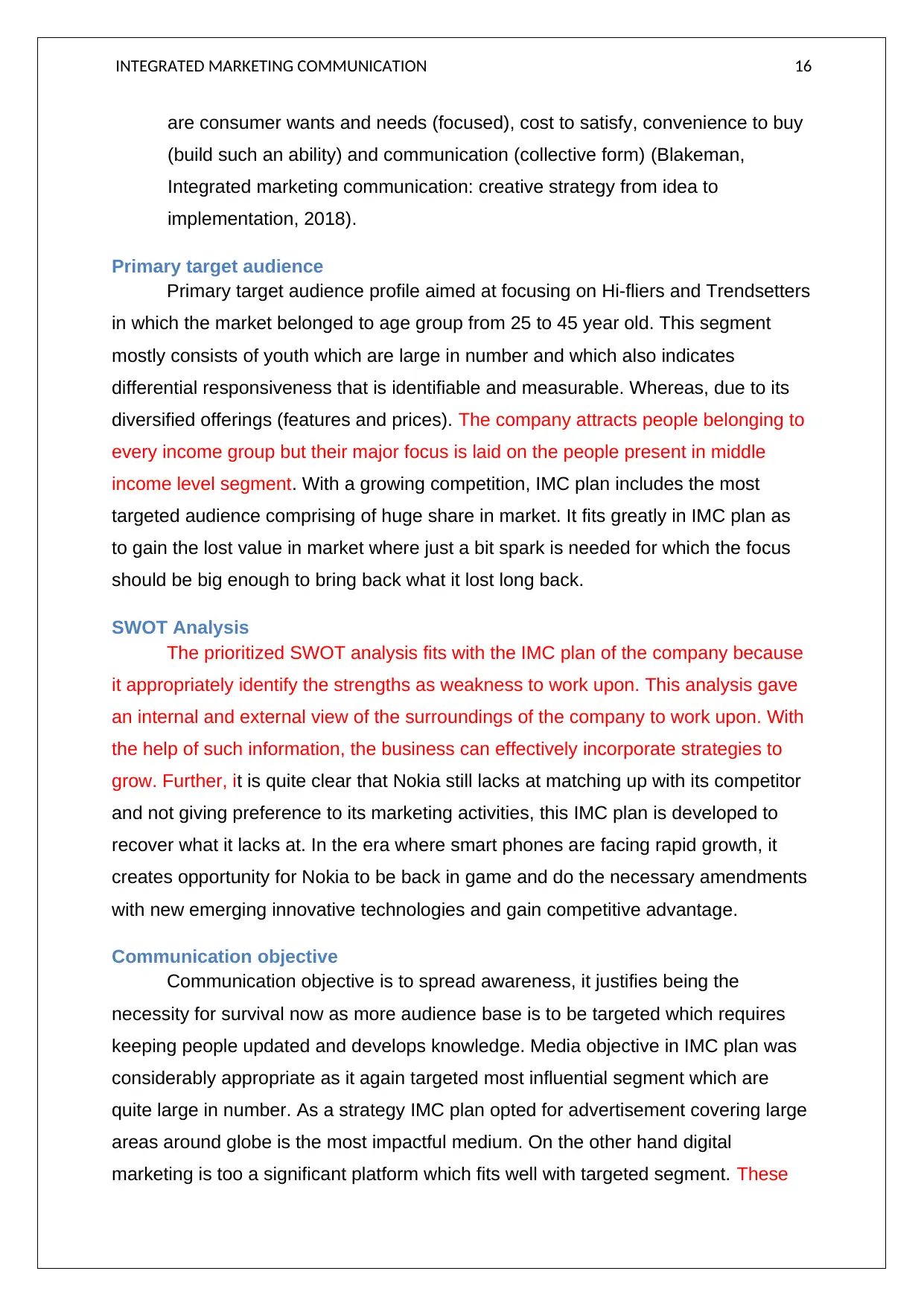
INTEGRATED MARKETING COMMUNICATION 16
are consumer wants and needs (focused), cost to satisfy, convenience to buy
(build such an ability) and communication (collective form) (Blakeman,
Integrated marketing communication: creative strategy from idea to
implementation, 2018).
Primary target audience
Primary target audience profile aimed at focusing on Hi-fliers and Trendsetters
in which the market belonged to age group from 25 to 45 year old. This segment
mostly consists of youth which are large in number and which also indicates
differential responsiveness that is identifiable and measurable. Whereas, due to its
diversified offerings (features and prices). The company attracts people belonging to
every income group but their major focus is laid on the people present in middle
income level segment. With a growing competition, IMC plan includes the most
targeted audience comprising of huge share in market. It fits greatly in IMC plan as
to gain the lost value in market where just a bit spark is needed for which the focus
should be big enough to bring back what it lost long back.
SWOT Analysis
The prioritized SWOT analysis fits with the IMC plan of the company because
it appropriately identify the strengths as weakness to work upon. This analysis gave
an internal and external view of the surroundings of the company to work upon. With
the help of such information, the business can effectively incorporate strategies to
grow. Further, it is quite clear that Nokia still lacks at matching up with its competitor
and not giving preference to its marketing activities, this IMC plan is developed to
recover what it lacks at. In the era where smart phones are facing rapid growth, it
creates opportunity for Nokia to be back in game and do the necessary amendments
with new emerging innovative technologies and gain competitive advantage.
Communication objective
Communication objective is to spread awareness, it justifies being the
necessity for survival now as more audience base is to be targeted which requires
keeping people updated and develops knowledge. Media objective in IMC plan was
considerably appropriate as it again targeted most influential segment which are
quite large in number. As a strategy IMC plan opted for advertisement covering large
areas around globe is the most impactful medium. On the other hand digital
marketing is too a significant platform which fits well with targeted segment. These
are consumer wants and needs (focused), cost to satisfy, convenience to buy
(build such an ability) and communication (collective form) (Blakeman,
Integrated marketing communication: creative strategy from idea to
implementation, 2018).
Primary target audience
Primary target audience profile aimed at focusing on Hi-fliers and Trendsetters
in which the market belonged to age group from 25 to 45 year old. This segment
mostly consists of youth which are large in number and which also indicates
differential responsiveness that is identifiable and measurable. Whereas, due to its
diversified offerings (features and prices). The company attracts people belonging to
every income group but their major focus is laid on the people present in middle
income level segment. With a growing competition, IMC plan includes the most
targeted audience comprising of huge share in market. It fits greatly in IMC plan as
to gain the lost value in market where just a bit spark is needed for which the focus
should be big enough to bring back what it lost long back.
SWOT Analysis
The prioritized SWOT analysis fits with the IMC plan of the company because
it appropriately identify the strengths as weakness to work upon. This analysis gave
an internal and external view of the surroundings of the company to work upon. With
the help of such information, the business can effectively incorporate strategies to
grow. Further, it is quite clear that Nokia still lacks at matching up with its competitor
and not giving preference to its marketing activities, this IMC plan is developed to
recover what it lacks at. In the era where smart phones are facing rapid growth, it
creates opportunity for Nokia to be back in game and do the necessary amendments
with new emerging innovative technologies and gain competitive advantage.
Communication objective
Communication objective is to spread awareness, it justifies being the
necessity for survival now as more audience base is to be targeted which requires
keeping people updated and develops knowledge. Media objective in IMC plan was
considerably appropriate as it again targeted most influential segment which are
quite large in number. As a strategy IMC plan opted for advertisement covering large
areas around globe is the most impactful medium. On the other hand digital
marketing is too a significant platform which fits well with targeted segment. These
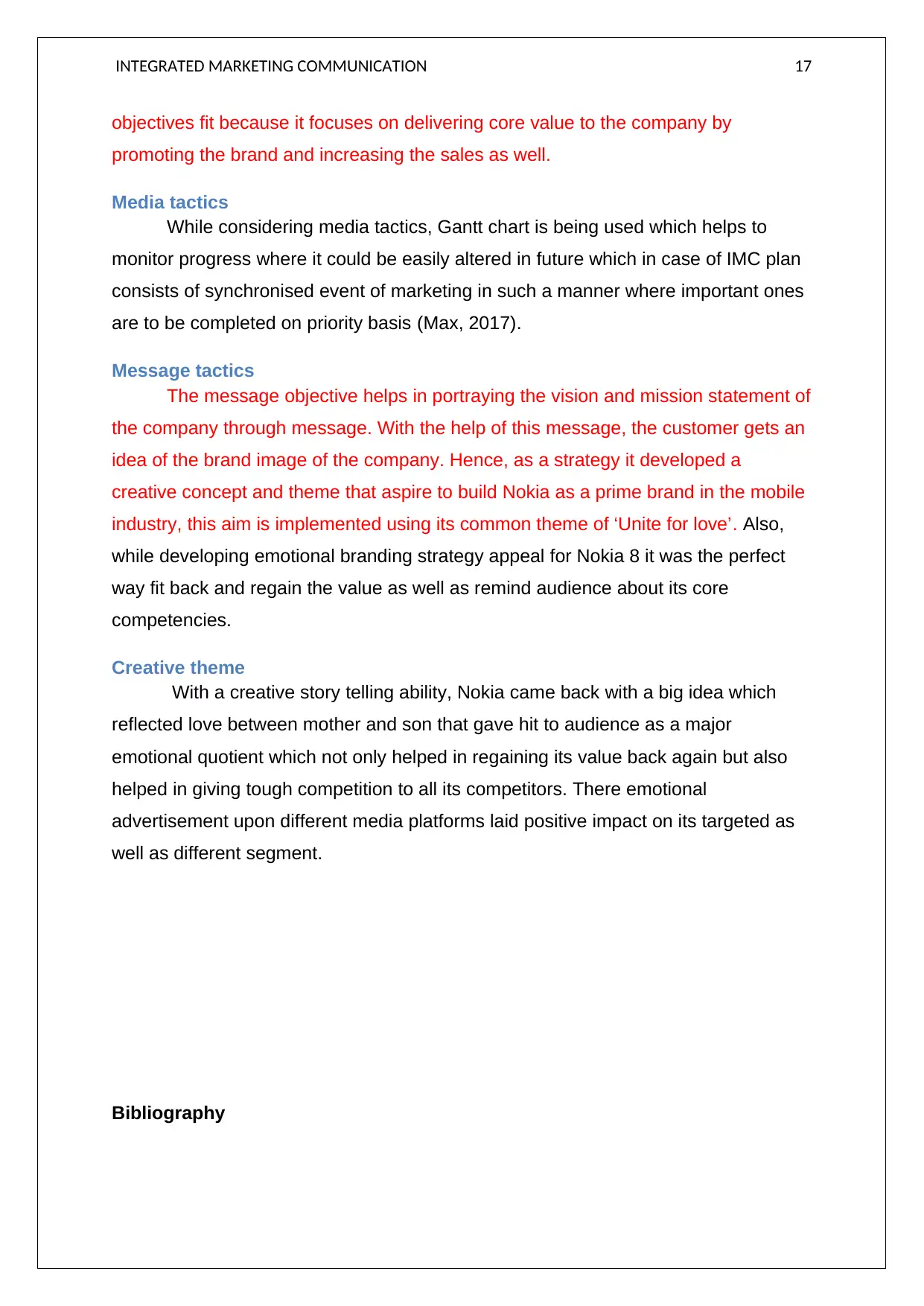
INTEGRATED MARKETING COMMUNICATION 17
objectives fit because it focuses on delivering core value to the company by
promoting the brand and increasing the sales as well.
Media tactics
While considering media tactics, Gantt chart is being used which helps to
monitor progress where it could be easily altered in future which in case of IMC plan
consists of synchronised event of marketing in such a manner where important ones
are to be completed on priority basis (Max, 2017).
Message tactics
The message objective helps in portraying the vision and mission statement of
the company through message. With the help of this message, the customer gets an
idea of the brand image of the company. Hence, as a strategy it developed a
creative concept and theme that aspire to build Nokia as a prime brand in the mobile
industry, this aim is implemented using its common theme of ‘Unite for love’. Also,
while developing emotional branding strategy appeal for Nokia 8 it was the perfect
way fit back and regain the value as well as remind audience about its core
competencies.
Creative theme
With a creative story telling ability, Nokia came back with a big idea which
reflected love between mother and son that gave hit to audience as a major
emotional quotient which not only helped in regaining its value back again but also
helped in giving tough competition to all its competitors. There emotional
advertisement upon different media platforms laid positive impact on its targeted as
well as different segment.
Bibliography
objectives fit because it focuses on delivering core value to the company by
promoting the brand and increasing the sales as well.
Media tactics
While considering media tactics, Gantt chart is being used which helps to
monitor progress where it could be easily altered in future which in case of IMC plan
consists of synchronised event of marketing in such a manner where important ones
are to be completed on priority basis (Max, 2017).
Message tactics
The message objective helps in portraying the vision and mission statement of
the company through message. With the help of this message, the customer gets an
idea of the brand image of the company. Hence, as a strategy it developed a
creative concept and theme that aspire to build Nokia as a prime brand in the mobile
industry, this aim is implemented using its common theme of ‘Unite for love’. Also,
while developing emotional branding strategy appeal for Nokia 8 it was the perfect
way fit back and regain the value as well as remind audience about its core
competencies.
Creative theme
With a creative story telling ability, Nokia came back with a big idea which
reflected love between mother and son that gave hit to audience as a major
emotional quotient which not only helped in regaining its value back again but also
helped in giving tough competition to all its competitors. There emotional
advertisement upon different media platforms laid positive impact on its targeted as
well as different segment.
Bibliography
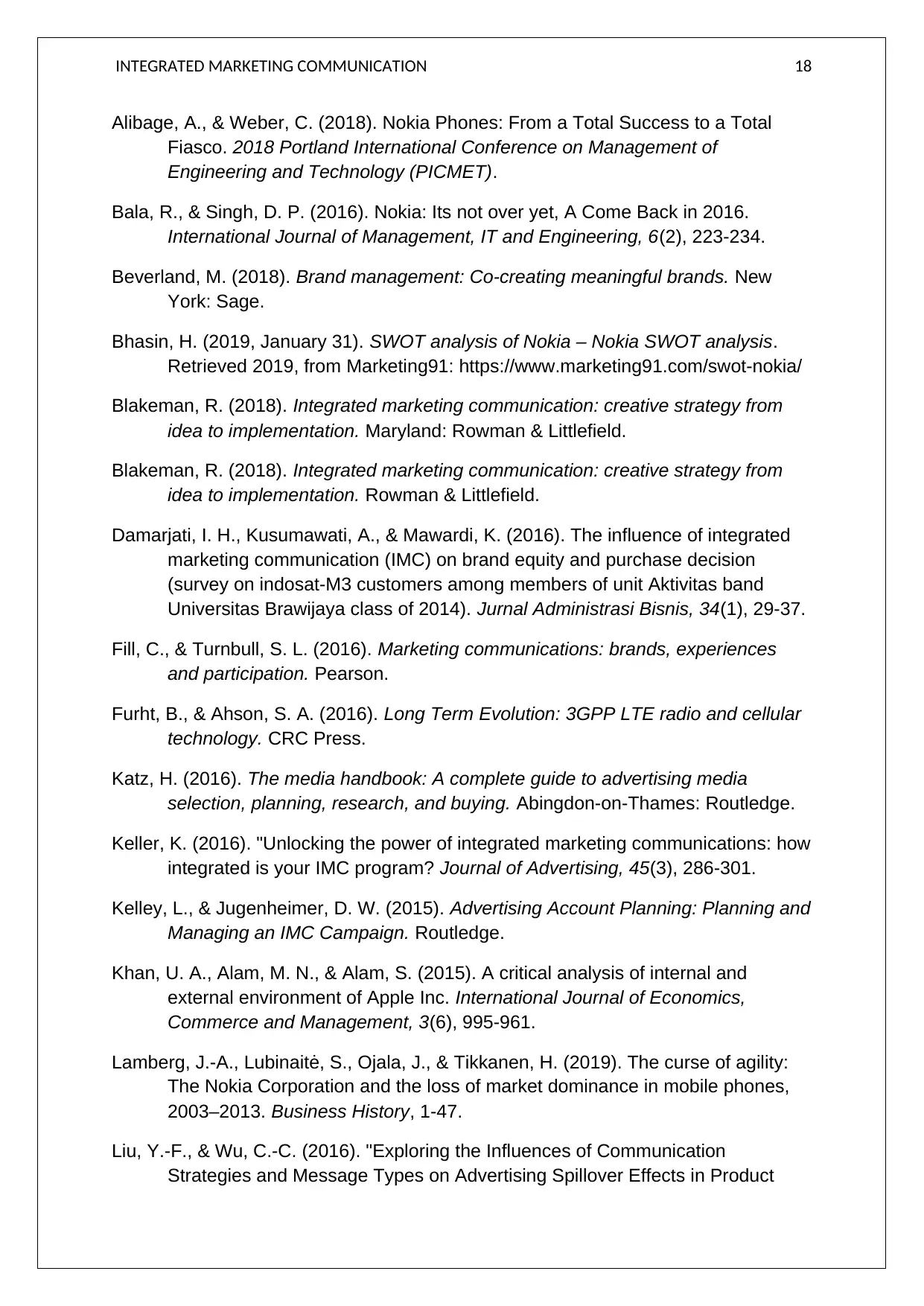
INTEGRATED MARKETING COMMUNICATION 18
Alibage, A., & Weber, C. (2018). Nokia Phones: From a Total Success to a Total
Fiasco. 2018 Portland International Conference on Management of
Engineering and Technology (PICMET).
Bala, R., & Singh, D. P. (2016). Nokia: Its not over yet, A Come Back in 2016.
International Journal of Management, IT and Engineering, 6(2), 223-234.
Beverland, M. (2018). Brand management: Co-creating meaningful brands. New
York: Sage.
Bhasin, H. (2019, January 31). SWOT analysis of Nokia – Nokia SWOT analysis.
Retrieved 2019, from Marketing91: https://www.marketing91.com/swot-nokia/
Blakeman, R. (2018). Integrated marketing communication: creative strategy from
idea to implementation. Maryland: Rowman & Littlefield.
Blakeman, R. (2018). Integrated marketing communication: creative strategy from
idea to implementation. Rowman & Littlefield.
Damarjati, I. H., Kusumawati, A., & Mawardi, K. (2016). The influence of integrated
marketing communication (IMC) on brand equity and purchase decision
(survey on indosat-M3 customers among members of unit Aktivitas band
Universitas Brawijaya class of 2014). Jurnal Administrasi Bisnis, 34(1), 29-37.
Fill, C., & Turnbull, S. L. (2016). Marketing communications: brands, experiences
and participation. Pearson.
Furht, B., & Ahson, S. A. (2016). Long Term Evolution: 3GPP LTE radio and cellular
technology. CRC Press.
Katz, H. (2016). The media handbook: A complete guide to advertising media
selection, planning, research, and buying. Abingdon-on-Thames: Routledge.
Keller, K. (2016). "Unlocking the power of integrated marketing communications: how
integrated is your IMC program? Journal of Advertising, 45(3), 286-301.
Kelley, L., & Jugenheimer, D. W. (2015). Advertising Account Planning: Planning and
Managing an IMC Campaign. Routledge.
Khan, U. A., Alam, M. N., & Alam, S. (2015). A critical analysis of internal and
external environment of Apple Inc. International Journal of Economics,
Commerce and Management, 3(6), 995-961.
Lamberg, J.-A., Lubinaitė, S., Ojala, J., & Tikkanen, H. (2019). The curse of agility:
The Nokia Corporation and the loss of market dominance in mobile phones,
2003–2013. Business History, 1-47.
Liu, Y.-F., & Wu, C.-C. (2016). "Exploring the Influences of Communication
Strategies and Message Types on Advertising Spillover Effects in Product
Alibage, A., & Weber, C. (2018). Nokia Phones: From a Total Success to a Total
Fiasco. 2018 Portland International Conference on Management of
Engineering and Technology (PICMET).
Bala, R., & Singh, D. P. (2016). Nokia: Its not over yet, A Come Back in 2016.
International Journal of Management, IT and Engineering, 6(2), 223-234.
Beverland, M. (2018). Brand management: Co-creating meaningful brands. New
York: Sage.
Bhasin, H. (2019, January 31). SWOT analysis of Nokia – Nokia SWOT analysis.
Retrieved 2019, from Marketing91: https://www.marketing91.com/swot-nokia/
Blakeman, R. (2018). Integrated marketing communication: creative strategy from
idea to implementation. Maryland: Rowman & Littlefield.
Blakeman, R. (2018). Integrated marketing communication: creative strategy from
idea to implementation. Rowman & Littlefield.
Damarjati, I. H., Kusumawati, A., & Mawardi, K. (2016). The influence of integrated
marketing communication (IMC) on brand equity and purchase decision
(survey on indosat-M3 customers among members of unit Aktivitas band
Universitas Brawijaya class of 2014). Jurnal Administrasi Bisnis, 34(1), 29-37.
Fill, C., & Turnbull, S. L. (2016). Marketing communications: brands, experiences
and participation. Pearson.
Furht, B., & Ahson, S. A. (2016). Long Term Evolution: 3GPP LTE radio and cellular
technology. CRC Press.
Katz, H. (2016). The media handbook: A complete guide to advertising media
selection, planning, research, and buying. Abingdon-on-Thames: Routledge.
Keller, K. (2016). "Unlocking the power of integrated marketing communications: how
integrated is your IMC program? Journal of Advertising, 45(3), 286-301.
Kelley, L., & Jugenheimer, D. W. (2015). Advertising Account Planning: Planning and
Managing an IMC Campaign. Routledge.
Khan, U. A., Alam, M. N., & Alam, S. (2015). A critical analysis of internal and
external environment of Apple Inc. International Journal of Economics,
Commerce and Management, 3(6), 995-961.
Lamberg, J.-A., Lubinaitė, S., Ojala, J., & Tikkanen, H. (2019). The curse of agility:
The Nokia Corporation and the loss of market dominance in mobile phones,
2003–2013. Business History, 1-47.
Liu, Y.-F., & Wu, C.-C. (2016). "Exploring the Influences of Communication
Strategies and Message Types on Advertising Spillover Effects in Product
Paraphrase This Document
Need a fresh take? Get an instant paraphrase of this document with our AI Paraphraser
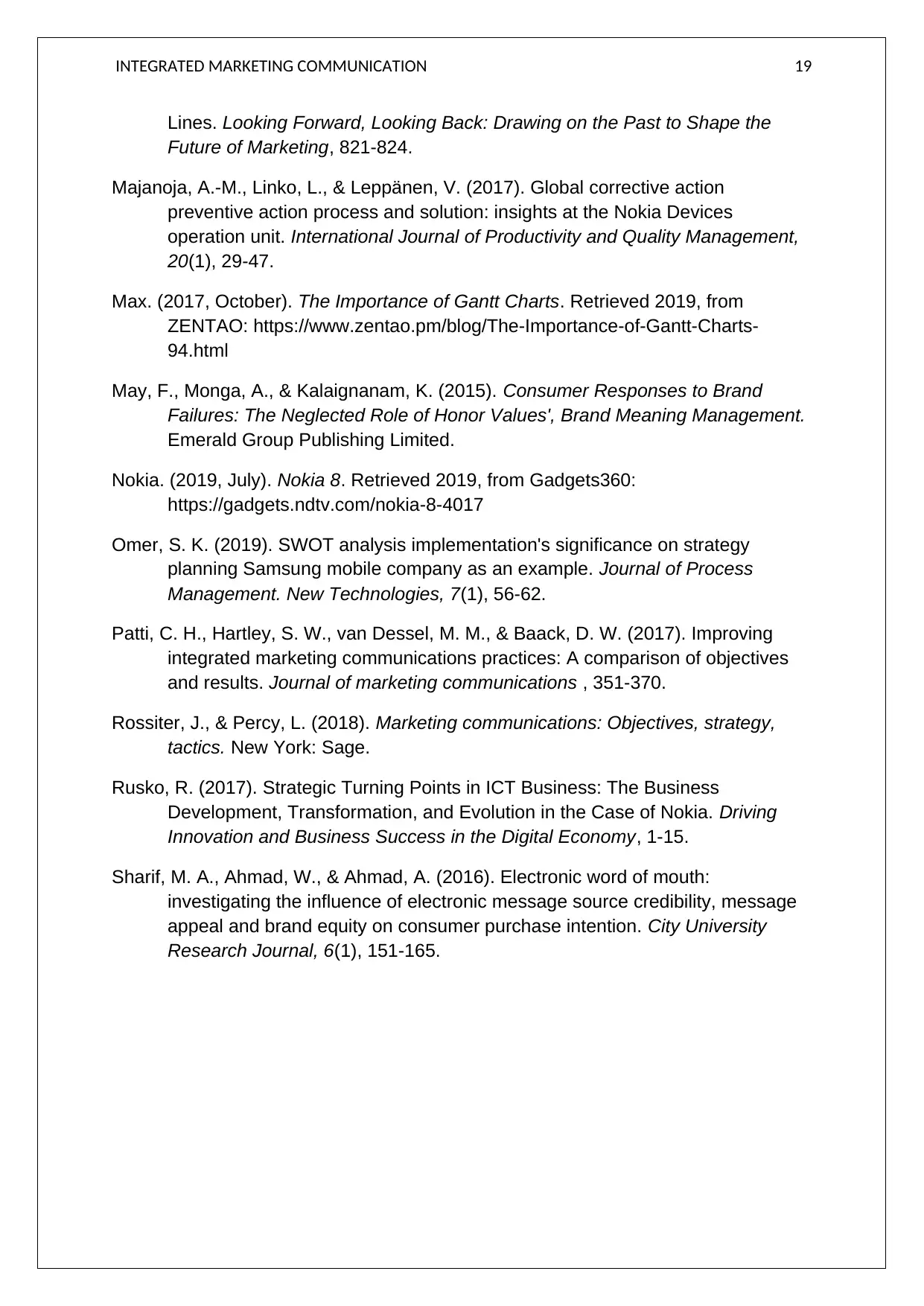
INTEGRATED MARKETING COMMUNICATION 19
Lines. Looking Forward, Looking Back: Drawing on the Past to Shape the
Future of Marketing, 821-824.
Majanoja, A.-M., Linko, L., & Leppänen, V. (2017). Global corrective action
preventive action process and solution: insights at the Nokia Devices
operation unit. International Journal of Productivity and Quality Management,
20(1), 29-47.
Max. (2017, October). The Importance of Gantt Charts. Retrieved 2019, from
ZENTAO: https://www.zentao.pm/blog/The-Importance-of-Gantt-Charts-
94.html
May, F., Monga, A., & Kalaignanam, K. (2015). Consumer Responses to Brand
Failures: The Neglected Role of Honor Values', Brand Meaning Management.
Emerald Group Publishing Limited.
Nokia. (2019, July). Nokia 8. Retrieved 2019, from Gadgets360:
https://gadgets.ndtv.com/nokia-8-4017
Omer, S. K. (2019). SWOT analysis implementation's significance on strategy
planning Samsung mobile company as an example. Journal of Process
Management. New Technologies, 7(1), 56-62.
Patti, C. H., Hartley, S. W., van Dessel, M. M., & Baack, D. W. (2017). Improving
integrated marketing communications practices: A comparison of objectives
and results. Journal of marketing communications , 351-370.
Rossiter, J., & Percy, L. (2018). Marketing communications: Objectives, strategy,
tactics. New York: Sage.
Rusko, R. (2017). Strategic Turning Points in ICT Business: The Business
Development, Transformation, and Evolution in the Case of Nokia. Driving
Innovation and Business Success in the Digital Economy, 1-15.
Sharif, M. A., Ahmad, W., & Ahmad, A. (2016). Electronic word of mouth:
investigating the influence of electronic message source credibility, message
appeal and brand equity on consumer purchase intention. City University
Research Journal, 6(1), 151-165.
Lines. Looking Forward, Looking Back: Drawing on the Past to Shape the
Future of Marketing, 821-824.
Majanoja, A.-M., Linko, L., & Leppänen, V. (2017). Global corrective action
preventive action process and solution: insights at the Nokia Devices
operation unit. International Journal of Productivity and Quality Management,
20(1), 29-47.
Max. (2017, October). The Importance of Gantt Charts. Retrieved 2019, from
ZENTAO: https://www.zentao.pm/blog/The-Importance-of-Gantt-Charts-
94.html
May, F., Monga, A., & Kalaignanam, K. (2015). Consumer Responses to Brand
Failures: The Neglected Role of Honor Values', Brand Meaning Management.
Emerald Group Publishing Limited.
Nokia. (2019, July). Nokia 8. Retrieved 2019, from Gadgets360:
https://gadgets.ndtv.com/nokia-8-4017
Omer, S. K. (2019). SWOT analysis implementation's significance on strategy
planning Samsung mobile company as an example. Journal of Process
Management. New Technologies, 7(1), 56-62.
Patti, C. H., Hartley, S. W., van Dessel, M. M., & Baack, D. W. (2017). Improving
integrated marketing communications practices: A comparison of objectives
and results. Journal of marketing communications , 351-370.
Rossiter, J., & Percy, L. (2018). Marketing communications: Objectives, strategy,
tactics. New York: Sage.
Rusko, R. (2017). Strategic Turning Points in ICT Business: The Business
Development, Transformation, and Evolution in the Case of Nokia. Driving
Innovation and Business Success in the Digital Economy, 1-15.
Sharif, M. A., Ahmad, W., & Ahmad, A. (2016). Electronic word of mouth:
investigating the influence of electronic message source credibility, message
appeal and brand equity on consumer purchase intention. City University
Research Journal, 6(1), 151-165.
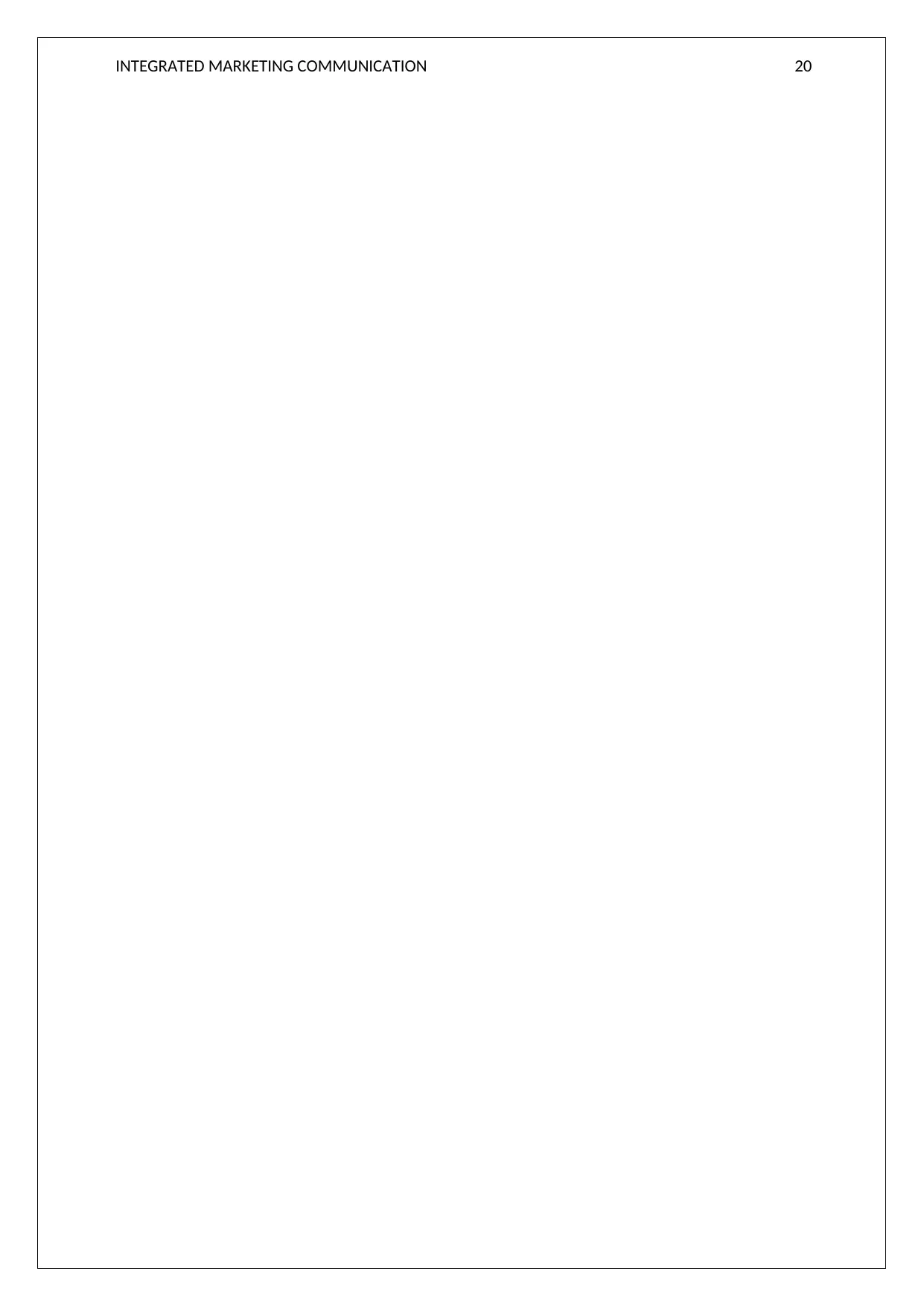
INTEGRATED MARKETING COMMUNICATION 20
1 out of 21
Related Documents
Your All-in-One AI-Powered Toolkit for Academic Success.
+13062052269
info@desklib.com
Available 24*7 on WhatsApp / Email
![[object Object]](/_next/static/media/star-bottom.7253800d.svg)
Unlock your academic potential
© 2024 | Zucol Services PVT LTD | All rights reserved.





